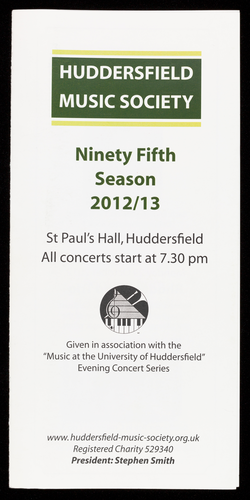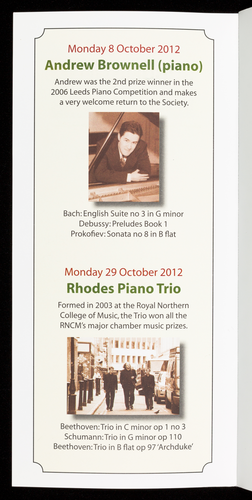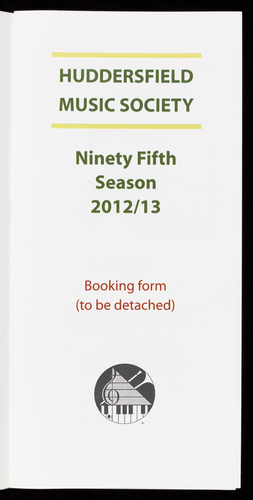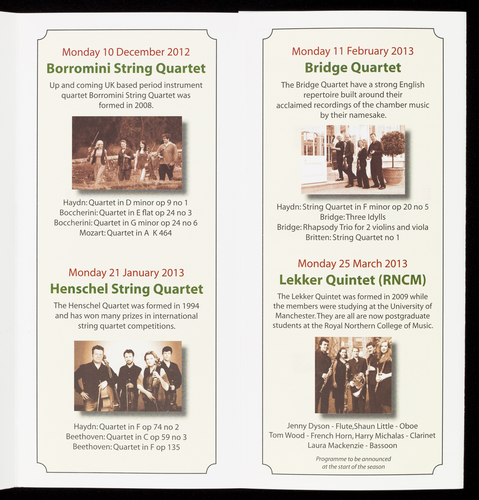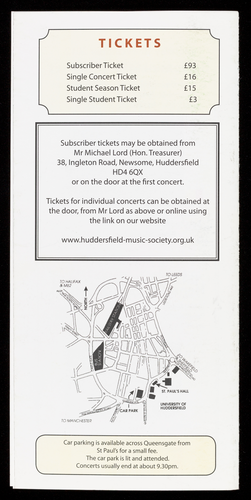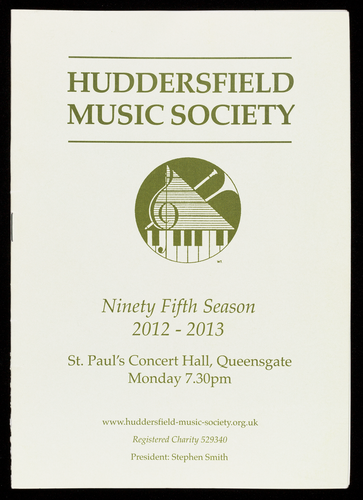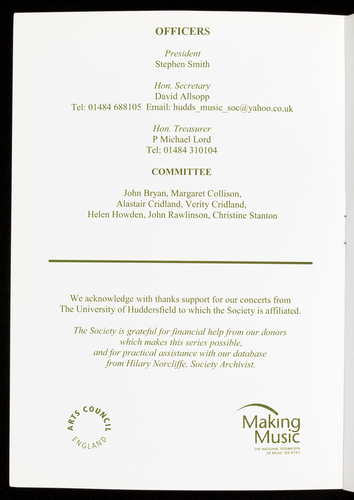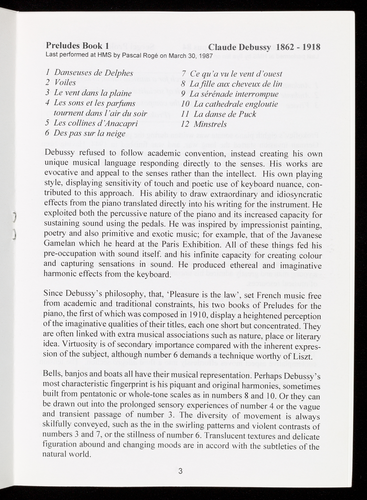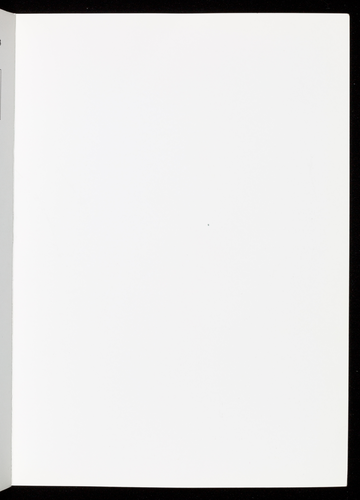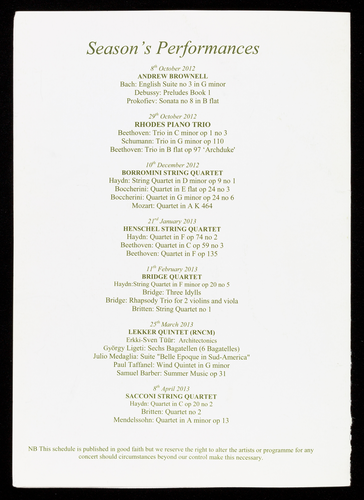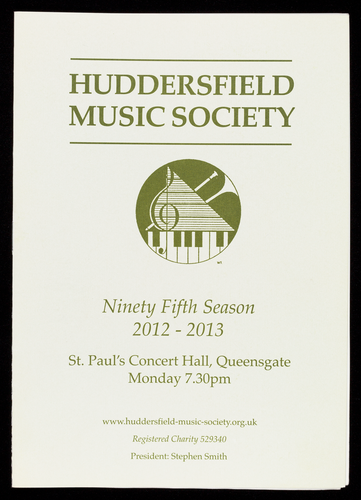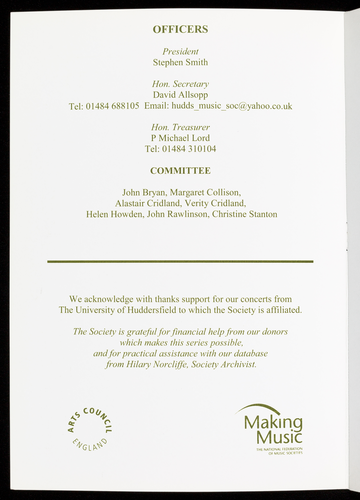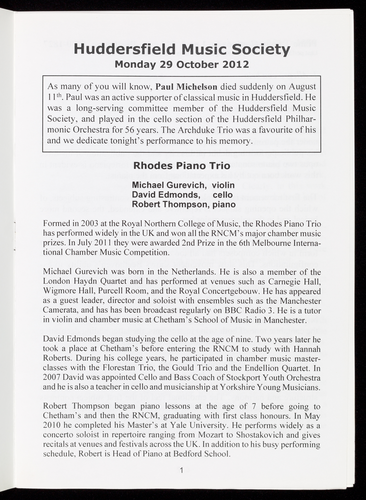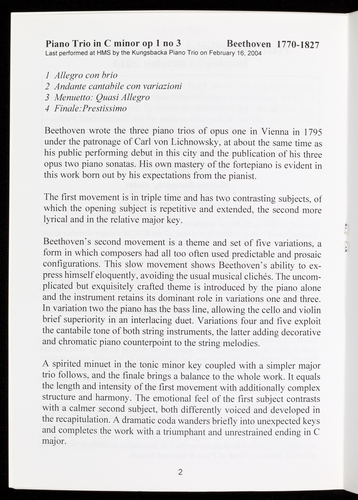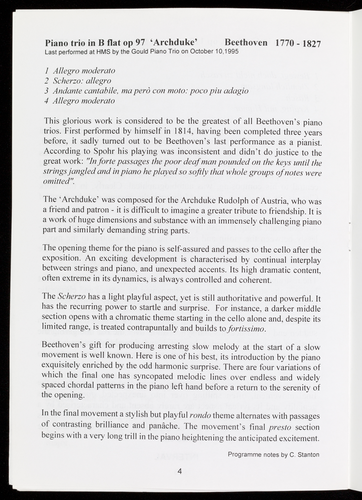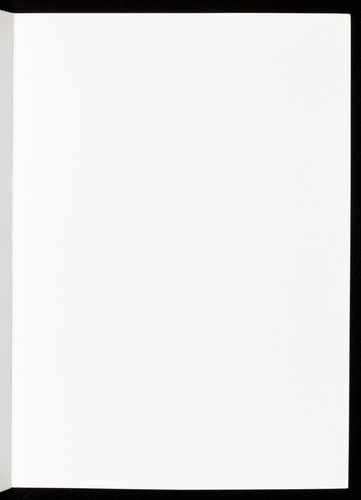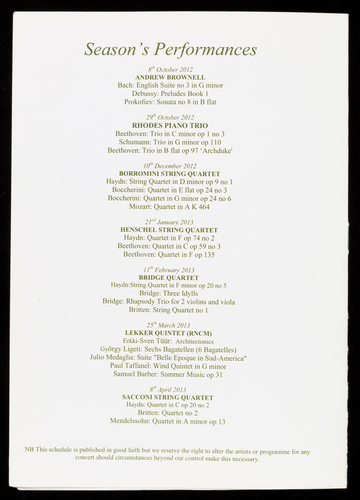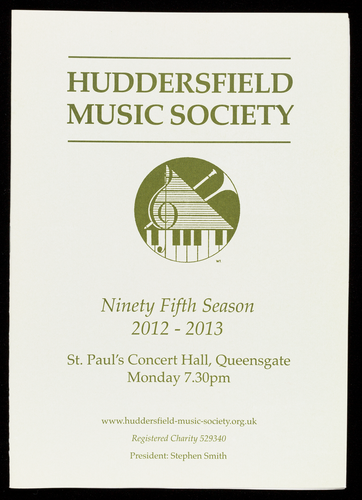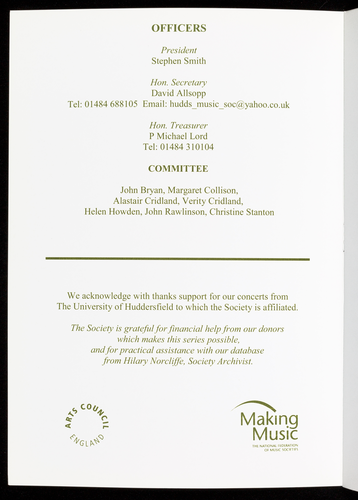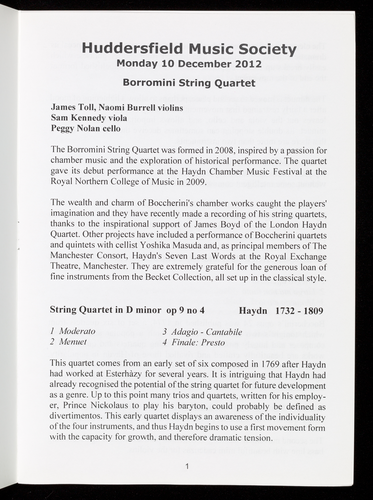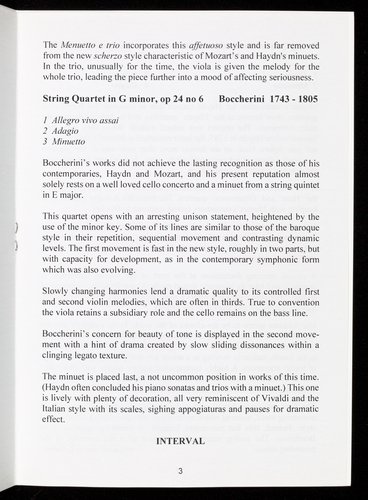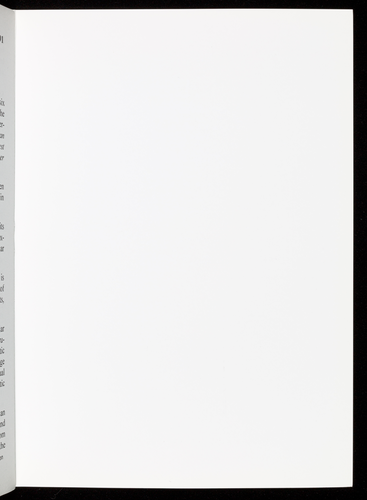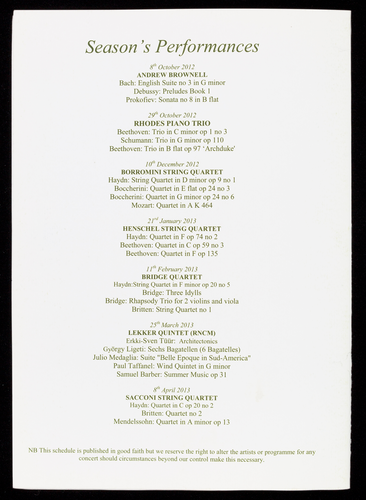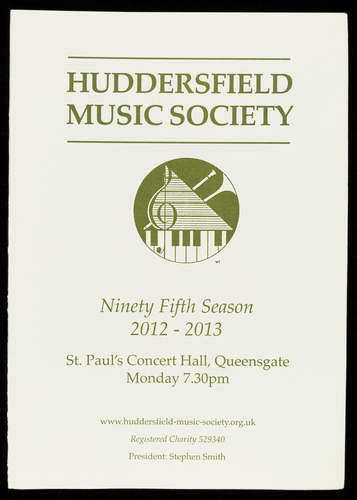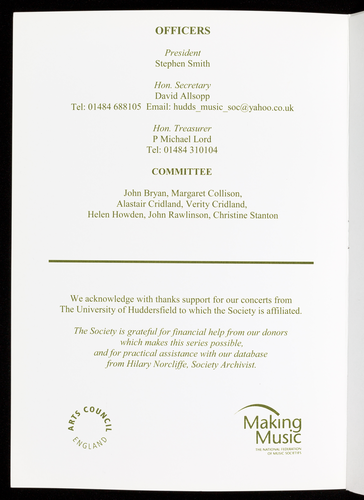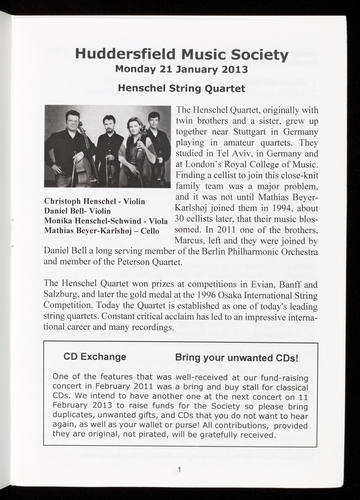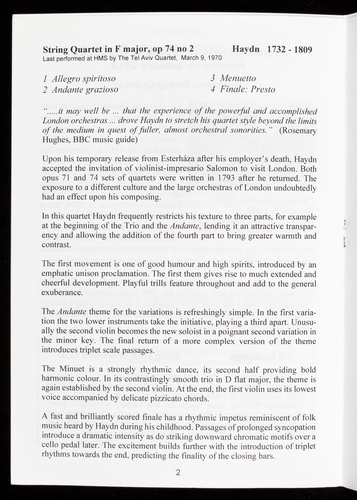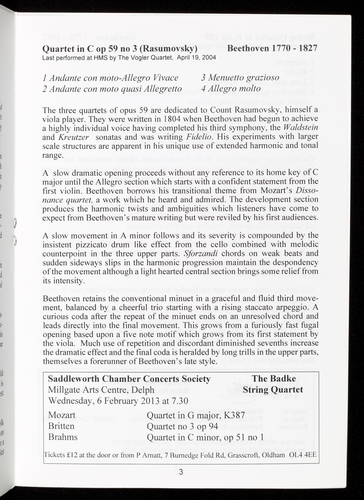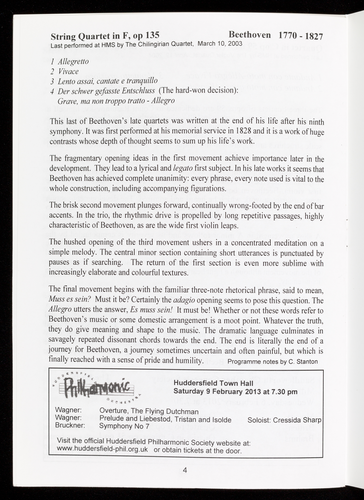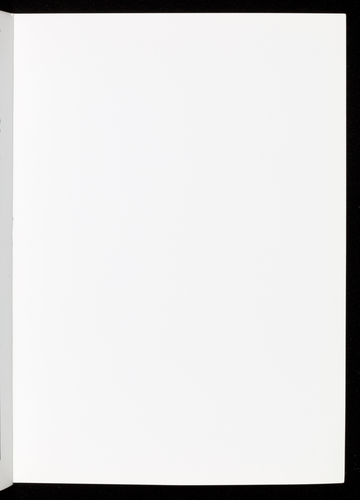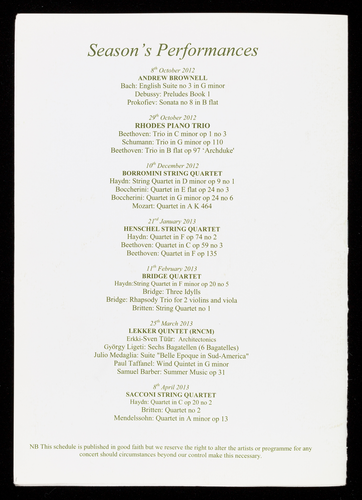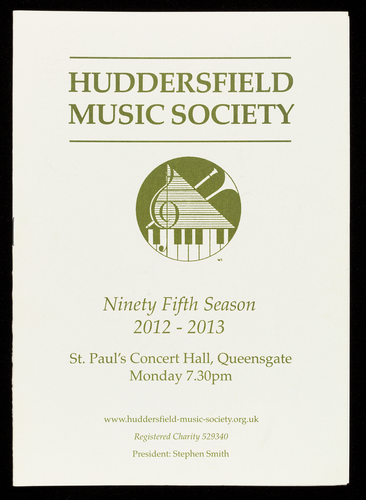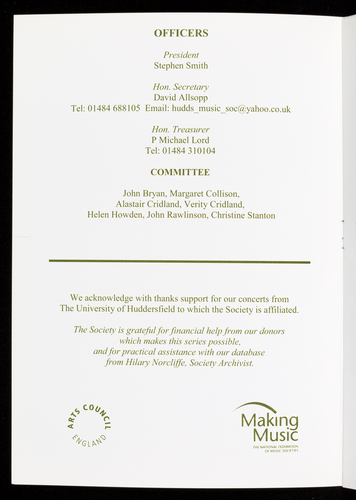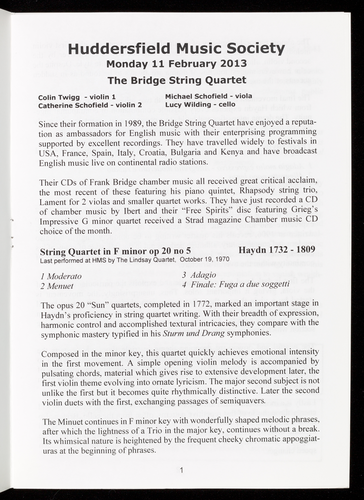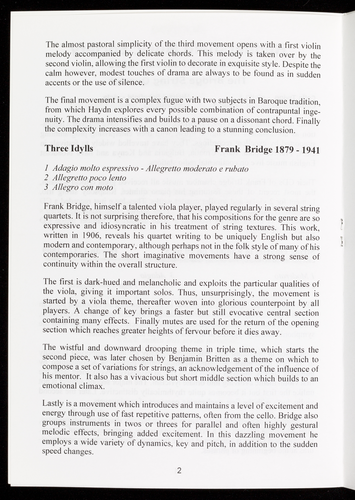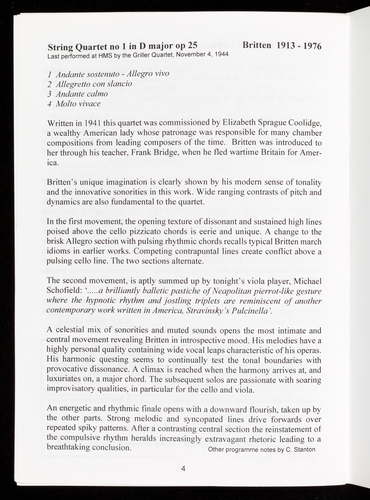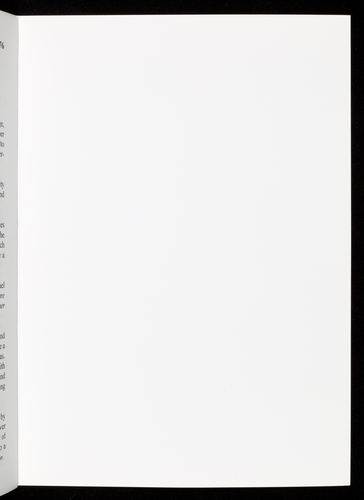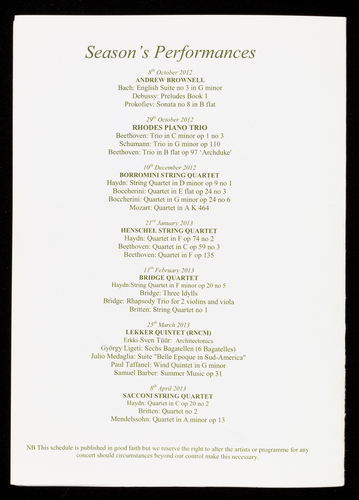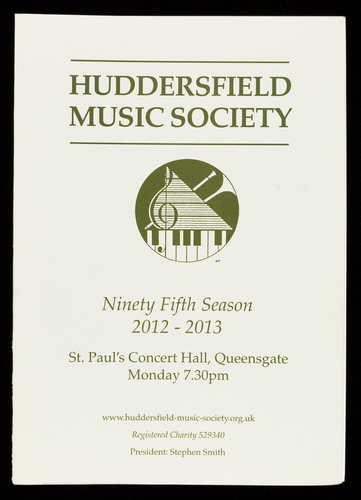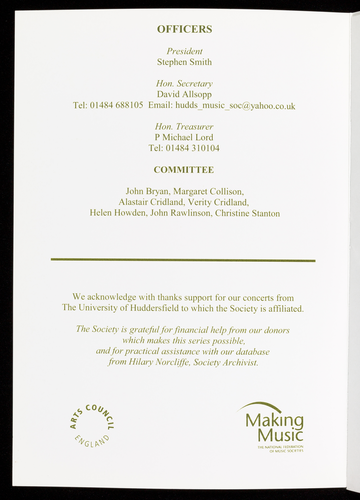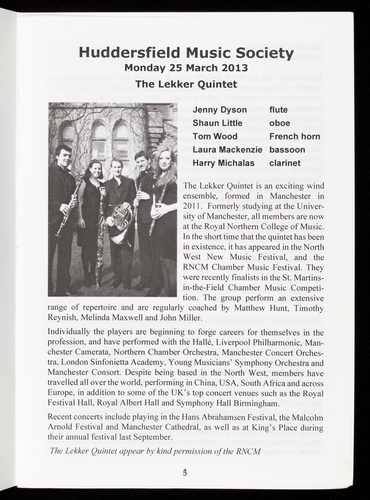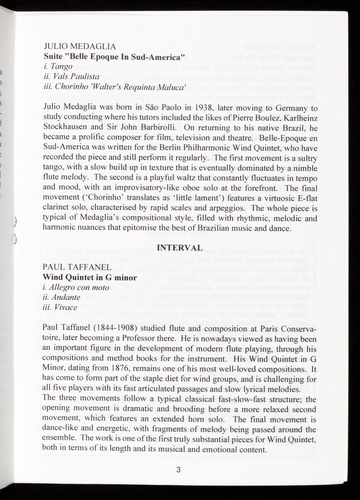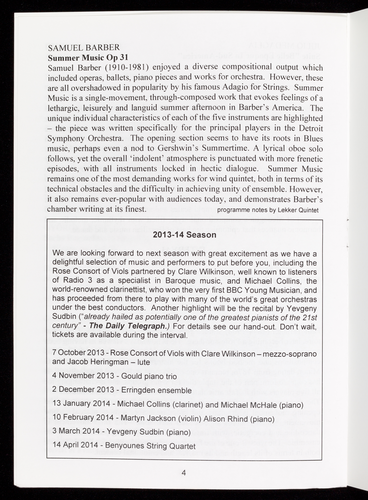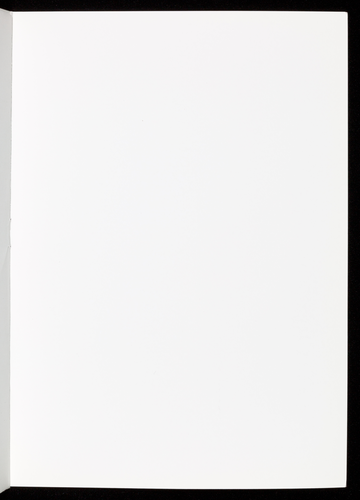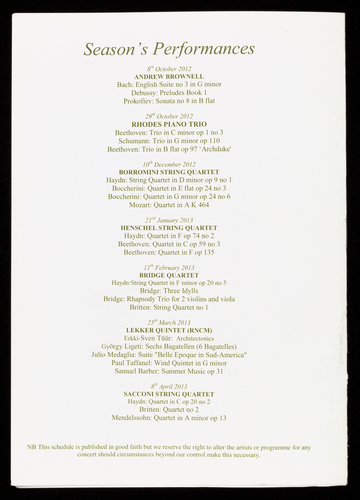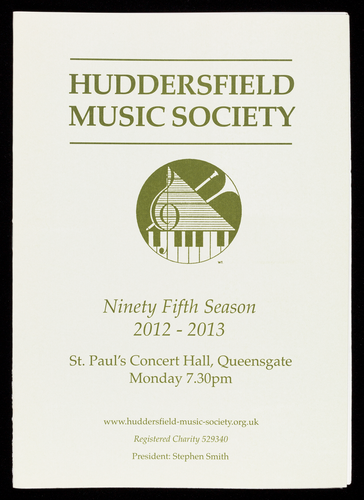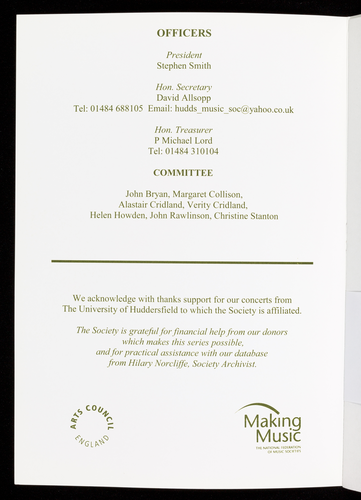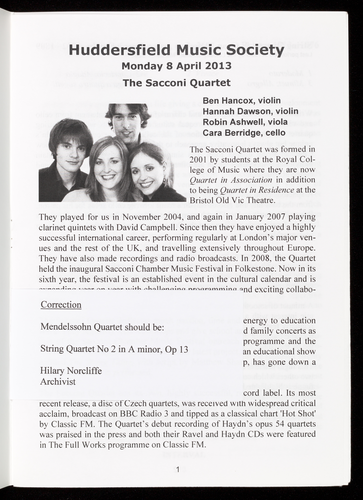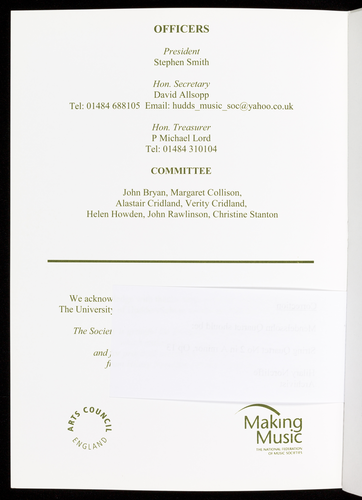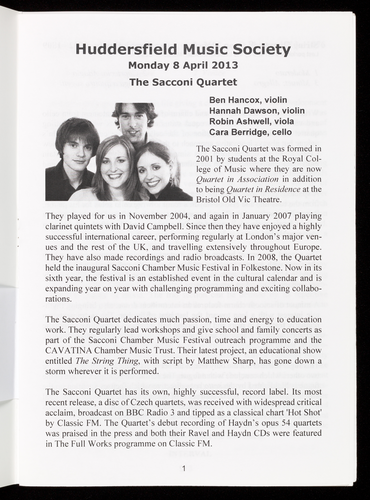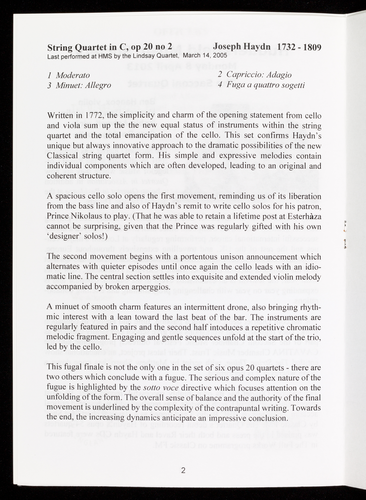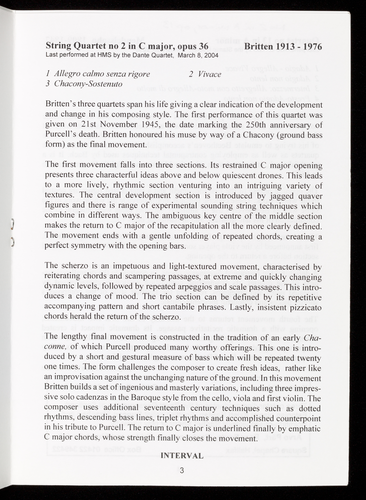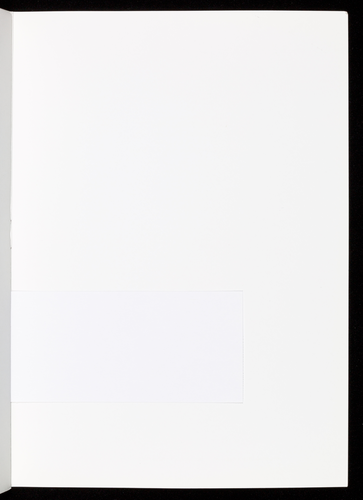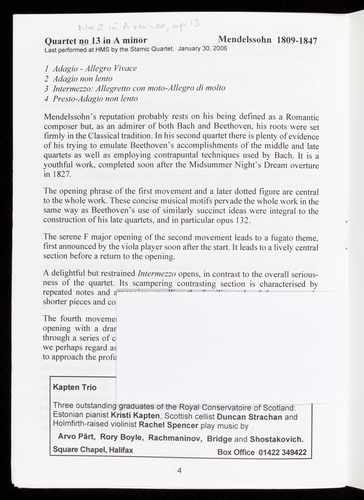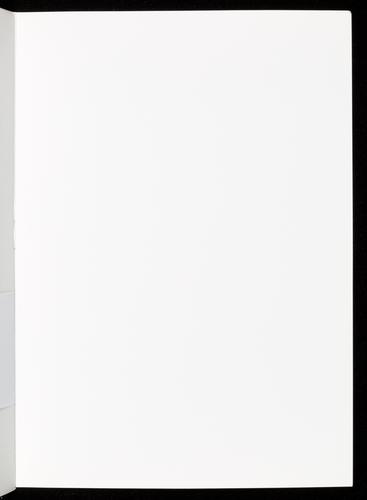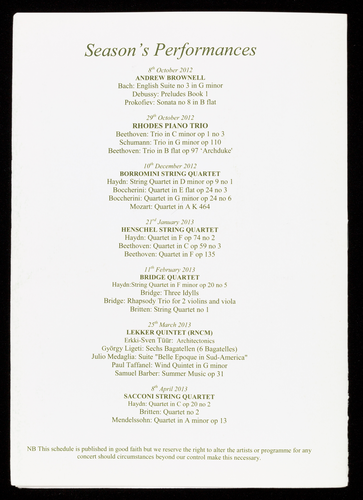Ocr'd Text:
HUDDERSFIELD
MUSIC SOCIETY
Ninety Fifth
Season
2012/13
St Paul's Hall, Huddersfield
All concerts start at 7.30 pm
11133
WI
Given in association with the
"Music at the University of Huddersfield"
Evening Concert Series
www.huddersfield-music-society.org.uk
Registered Charity 529340
President: Stephen Smith
Ocr'd Text:
Monday 8 October 2012
Andrew Brownell (piano)
Andrew was the 2nd prize winner in the
2006 Leeds Piano Competition and makes
a very welcome return to the Society.
AN
Gabar
Bach: English Suite no 3 in G minor
Debussy: Preludes Book 1
Prokofiev: Sonata no 8 in B flat
Monday 29 October 2012
Rhodes Piano Trio
Formed in 2003 at the Royal Northern
College of Music, the Trio won all the
RNCM's major chamber music prizes.
Beethoven: Trio in C minor op 1 no 3
Schumann: Trio in G minor op 110
Beethoven: Trio in B flat op 97 'Archduke'
Ocr'd Text:
HUDDERSFIELD
MUSIC SOCIETY
Ninety Fifth
Season
2012/13
Booking form
(to be detached)
WI
Ocr'd Text:
Monday 10 December 2012
Borromini String Quartet
Up and coming UK based period instrument
quartet Borromini String Quartet was
formed in 2008.
Haydn: Quartet in D minor op 9 no 1
Boccherini: Quartet in E flat op 24 no 3
Boccherini: Quartet in G minor op 24 no 6
Mozart: Quartet in A K 464
Monday 21 January 2013
Henschel String Quartet
The Henschel Quartet was formed in 1994
and has won many prizes in international
string quartet competitions.
Haydn: Quartet in F op 74 no 2
Beethoven: Quartet in C op 59 no 3
Beethoven: Quartet in F op 135
Monday 11 February 2013
Bridge Quartet
The Bridge Quartet have a strong English
repertoire built around their
acclaimed recordings of the chamber music
by their namesake.
4
Haydn: String Quartet in F minor op 20 no 5
Bridge: Three Idylls
Bridge: Rhapsody Trio for 2 violins and viola
Britten: String Quartet no 1
Monday 25 March 2013
Lekker Quintet (RNCM)
The Lekker Quintet was formed in 2009 while
the members were studying at the University of
Manchester. They are all are now postgraduate
students at the Royal Northern College of Music.
Jenny Dyson - Flute,Shaun Little - Oboe
Tom Wood - French Horn, Harry Michalas - Clarinet
Laura Mackenzie - Bassoon
Programme to be announced
at the start of the season
Ocr'd Text:
Subscriber Ticket
Single Concert Ticket
Student Season Ticket
Single Student Ticket
Booking arrangements
Tickets may be obtained by using the booking form below or at the door.
Please return unwanted season tickets to the
Treasurer by September 23rd 2012.
Post this form with cheque payable to
Huddersfield Music Society
to Hon. Treasurer
Mr. Michael Lord,
38 Ingleton Rd, Newsome, Huddersfield HD4 6QX. Tel 01484 310104
for
TICKETS
Single concert tickets may be bought online using the link on our website
www.huddersfield-music-society.org.uk
Please send ............ subscriber tickets
Name
Please send ............ single concert tickets
Address
Postcode
BOOKING FORM
I enclose cheque
£93
£16
£15
£3
........
Telephone
Total £
.......
(dates)
Monday 8 April 2013
Sacconi String Quartet
Since its formation at the
Royal College of Music in 2001,
the Sacconi Quartet has established
a secure and substantial reputation.
This is their third visit to Huddersfield.
Haydn: Quartet in C op 20 no 2
Britten: Quartet no 2
Mendelssohn: Quartet in A minor op 13
We acknowledge with thanks support from
the University of Huddersfield
to which the Society is affiliated.
The Society is grateful for financial help from
our donors which makes this series
possible and for support from:
Making Music
(National Federation of Music Societies)
and the Countess of Munster Trust.
NB This brochure is published in good faith
but we reserve the right to alter the artists
or programme for any concert
should circumstances beyond our control
make this necessary.
Ocr'd Text:
Subscriber Ticket
Single Concert Ticket
Student Season Ticket
Single Student Ticket
Subscriber tickets may be obtained from
Mr Michael Lord (Hon. Treasurer)
38, Ingleton Road, Newsome, Huddersfield
HD4 6QX
or on the door at the first concert.
HARY
Tickets for individual concerts can be obtained at
the door, from Mr Lord as above or online using
the link on our website
www.huddersfield-music-society.org.uk
kyykkäidelis a li
"
TICKETS
bed
NORTH
TO MANCHESTER
AMOR ROAD
RAILWAY STATION
SUO
1009
00000
007
OOV
500
2000
£93
£16
£15
£3
CAR PARK
SHEFFIELD
ST. PAUL'S HALL
UNIVERSITY OF
HUDDERSFIELD
The car park is lit and attended.
Concerts usually end at about 9.30pm.
201² A
Car parking is available across Queensgate from
St Paul's for a small fee.
Ocr'd Text:
HUDDERSFIELD
MUSIC SOCIETY
WT.
Ninety Fifth Season
2012 - 2013
St. Paul's Concert Hall, Queensgate
Monday 7.30pm
www.huddersfield-music-society.org.uk
Registered Charity 529340
President: Stephen Smith
Ocr'd Text:
Hon. Secretary
David Allsopp
Tel: 01484 688105 Email: hudds_music_soc@yahoo.co.uk
OFFICERS
ARTS
President
Stephen Smith
COUNCIL
-
ENGLAND
Hon. Treasurer
P Michael Lord
Tel: 01484 310104
John Bryan, Margaret Collison,
Alastair Cridland, Verity Cridland,
Helen Howden, John Rawlinson, Christine Stanton
We acknowledge with thanks support for our concerts from
The University of Huddersfield to which the Society is affiliated.
COMMITTEE
The Society is grateful for financial help from our donors
which makes this series possible,
and for practical assistance with our database
from Hilary Norcliffe, Society Archivist.
Making
Music
THE NATIONAL FEDERATION
OF MUSIC SOCIETIES
Ocr'd Text:
Huddersfield Music Society
Monday 8 October 2012
Andrew Brownell - Piano
mir
Since his 2nd Prize finish at the 2006 Leeds
International Piano Competition, Andrew
Brownell has played to enthusiastic audi-
ences across North America and Europe, and
press regularly remark on his musical integri-
ty, beauty of tone, and scholarly insight.
Musical Opinion wrote recently, "Brownell's
technique is fabulous, as is his innate musi-
cianship, sensitive and powerful"
Following his success in Leeds and his in-
creasing recognition in the United Kingdom,
Huddersfield Music Society took the oppor-
tunity of inviting him to play for us in March
2009. We are very pleased that he has again
been able to fit us in to his busy schedule.
Recent engagements have included a debut recital at Wigmore Hall in London,
ongoing collaborations with the Hummel Ensemble and the Wihan Quartet, and
world premieres of works by Pierre Thilloy, Bryan Kelly, and Ying Wang. This
season, Andrew plays with the Slovak Philharmonic, a debut recital at the
Gimhae Festival in South Korea, and other recitals and concerts throughout
Europe and North America.
He has played on BBC radio and television, Classic FM (UK), NPR, CBC,
Mitteldeutscher Rundfunk, and RBB KulturRadio. He has been soloist with
orchestras such as the Hallé, Slovak Philharmonic, the Hermitage State Orches-
tra, and with the Royal Liverpool Philharmonic under Owain Arwel Hughes in
Huddersfield Town Hall.
A native of Portland, Oregon, Andrew Brownell began studying the piano at the
age of four. His teachers have included Joan Havill at the Guildhall School of
Music in London, where he earned a doctorate. An enthusiastic collaborative
artist, Andrew Brownell was a member of a prize-winning trio at the 1996
Fischoff Chamber Music Competition (USA). Also an accomplished organist,
Andrew was formerly assistant organist at St. James' Episcopal Church, Los
Angeles, and was recently made a fellow of the Royal College of Organists.
1
Ocr'd Text:
English Suite no 3 in G minor
Last performed at HMS by Rosalyn Tureck on October 10, 1955
Prélude
Allemande
Courante
Gavotte 1 Gavotte 2
Gigue
The keyboard suite was a common instrumental form of the seventeenth and
eighteenth centuries in France, Germany and England. It linked together a
set of dance movements in a common key and often preceded by a prelude.
The intermingling of European styles, including the Italian, is apparent in
Bach's six English suites, written for the clavier around 1715 when he was
in Weimar. The set bore the title, 'Fait pour les Anglais' and they were
probably the combined result of an English commission and Bach's study of
the suites of a composer, Charles Dieupart, living in London at the time.
The suite opens with a crisply rhythmic Prélude, which is in fact a typical
Italian concerto movement, revealing how well Bach transferred the existing
instrumental forms to the keyboard. Its equivalent of the solo and returning
tutti sections are clearly marked. A flowing and gracious Allemande follows,
its simple two-section construction becoming the template for all the subse-
quent movements. Two triple-time movements are next; first a faster Cour-
ante with quaver movement and then a stately Sarabande providing
opportunity for decorative improvisation in its repeated sections. Of two
Gavottes, the first is lively, the second, a musette, derived from a small
French bagpipe with its characteristic drone. Finally a sparkling Gigue,
exhibiting an impressive display of counterpoint, completes the work.
Schubert Ensemble
JS Bach 1685 - 1750
Halifax Philharmonic Club
Piano Quartet in F minor op. 2
Piano Quintet in A minor op. 29
Piano Quintet in E flat major op. 44
Square Chapel, Halifax
2
Friday 19 October, at 7.30
Mendelssohn
Enescu
Schumann
Box Office 01422 349422
J
Ocr'd Text:
Preludes Book 1
Last performed at HMS by Pascal Rogé on March 30, 1987
1 Danseuses de Delphes
2 Voiles
3 Le vent dans la plaine
4 Les sons et les parfums
tournent dans l'air du soir
5 Les collines d'Anacapri
6 Des pas sur la neige
Claude Debussy 1862-1918
7 Ce qu'a vu le vent d'ouest
8 La fille aux cheveux de lin
9 La sérénade interrompue
10 La cathedrale engloutie
11 La danse de Puck
12 Minstrels
Debussy refused to follow academic convention, instead creating his own
unique musical language responding directly to the senses. His works are
evocative and appeal to the senses rather than the intellect. His own playing
style, displaying sensitivity of touch and poetic use of keyboard nuance, con-
tributed to this approach. His ability to draw extraordinary and idiosyncratic
effects from the piano translated directly into his writing for the instrument. He
exploited both the percussive nature of the piano and its increased capacity for
sustaining sound using the pedals. He was inspired by impressionist painting,
poetry and also primitive and exotic music; for example, that of the Javanese
Gamelan which he heard at the Paris Exhibition. All of these things fed his
pre-occupation with sound itself. and his infinite capacity for creating colour
and capturing sensations in sound. He produced ethereal and imaginative
harmonic effects from the keyboard.
Since Debussy's philosophy, that, 'Pleasure is the law', set French music free
from academic and traditional constraints, his two books of Preludes for the
piano, the first of which was composed in 1910, display a heightened perception
of the imaginative qualities of their titles, each one short but concentrated. They
are often linked with extra musical associations such as nature, place or literary
idea. Virtuosity is of secondary importance compared with the inherent expres-
sion of the subject, although number 6 demands a technique worthy of Liszt.
Bells, banjos and boats all have their musical representation. Perhaps Debussy's
most characteristic fingerprint is his piquant and original harmonies, sometimes
built from pentatonic or whole-tone scales as in numbers 8 and 10. Or they can
be drawn out into the prolonged sensory experiences of number 4 or the vague
and transient passage of number 3. The diversity of movement is always
skilfully conveyed, such as the in the swirling patterns and violent contrasts of
numbers 3 and 7, or the stillness of number 6. Translucent textures and delicate
figuration abound and changing moods are in accord with the subtleties of the
natural world.
3
Ocr'd Text:
Piano Sonata no 8 in B flat, opus 84
Last performed at HMS by Ilya Itin on September 29, 1997
1 Andante dolce
2 Andante sognando
3 Vivace
Sergei Prokofiev 1891-1953
The search for a musical idiom in keeping with
the epoch of socialism is a worthy, but difficult
task for the composer...'
(Prokofiev: article in Pravda 1937)
Prokofiev's eighth piano sonata was written during the period after 1941 when the
German invasion started the long war, and was finished in 1944. Having been
obliged to produce appropriately cheerful and patriotic works for the State, he
grasped the opportunity to give a true expression of his feelings in his piano sonatas.
This one was dedicated to Mira, his inspiration, and with whom he eventually lived.
Compared with his previous sonatas the music of the eighth seems understated. It
was acclaimed as a critical success however and won a Stalin prize, as did the first
performance of the first part of the Eisenstein film, "Ivan the Terrible" at virtually
the same time. Both works are powerful and profound, the music born of a long
struggle by artists in reconciling the demands of the State with artistic expression.
Prokofiev had also lived in Paris as a Russian exile in the twenties and undoubtedly
the absorption of the wit and gaiety of the sophisticated French artistic scene with
which he was involved, affected his composing. He had played Debussy's music as
a young man and greatly admired his unconventional and adventurous employment
of musical resources.
He began work on his well known fifth symphony at the same time as this sonata.
They share certain common characteristics, both are in B flat major and contain a
preponderance of slow meditative lyrical music. The sonata also has a mechanistic
aspect, perhaps suggested by the authorities in order to reflect the growing industri-
alisation of the Soviet Union.
The first movement is profound and weighty, falling into several sections. Its
contemplative aspect moves effortlessly into a fluid allegro section. The tension
relaxes in the short second movement, its triple time seems to create a gentle
rocking motion, most soothing after the desolation of the first movement.
An energetic and rhythmic final movement proceeds with determination and con-
tains all manner of extrovert flourishes and virtuosic figuration. Its resolute
marcato central section features short repeated notes often unexpectedly accented.
Towards the end it suddenly relaxes into a passage of beauty, to recall wistfully the
opening of the first movement, before a purposeful and authoritative conclusion in
bravura style.
Programme notes by C. Stanton
4
Ocr'd Text:
Season's Performances
8th October 2012
ANDREW BROWNELL
Bach: English Suite no 3 in G minor
Debussy: Preludes Book 1
Prokofiev: Sonata no 8 in B flat
29th October 2012
RHODES PIANO TRIO
Beethoven: Trio in C minor op 1 no 3
Schumann: Trio in G minor op 110
Beethoven: Trio in B flat op 97 'Archduke'
10th December 2012
BORROMINI STRING QUARTET
Haydn: String Quartet in D minor op 9 no 1
Boccherini: Quartet in E flat op 24 no 3
Boccherini: Quartet in G minor op 24 no 6
Mozart: Quartet in A K 464
21rd January 2013
HENSCHEL STRING QUARTET
Haydn: Quartet in F op 74 no 2
Beethoven: Quartet in C op 59 no 3
Beethoven: Quartet in F op 135
11th February 2013
BRIDGE QUARTET
Haydn: String Quartet in F minor op 20 no 5
Bridge: Three Idylls
Bridge: Rhapsody Trio for 2 violins and viola
Britten: String Quartet no 1
25th March 2013
LEKKER QUINTET (RNCM)
Erkki-Sven Tüür: Architectonics
György Ligeti: Sechs Bagatellen (6 Bagatelles)
Julio Medaglia: Suite "Belle Epoque in Sud-America"
Paul Taffanel: Wind Quintet in G minor
Samuel Barber: Summer Music op 31
8th April 2013
SACCONI STRING QUARTET
Haydn: Quartet in C op 20 no 2
Britten: Quartet no 2
Mendelssohn: Quartet in A minor op 13
NB This schedule is published in good faith but we reserve the right to alter the artists or programme for any
concert should circumstances beyond our control make this necessary.
Ocr'd Text:
HUDDERSFIELD
MUSIC SOCIETY
11
TIL
WT.
Ninety Fifth Season
2012-2013
St. Paul's Concert Hall, Queensgate
Monday 7.30pm
www.huddersfield-music-society.org.uk
Registered Charity 529340
President: Stephen Smith
Ocr'd Text:
Hon. Secretary
David Allsopp
Tel: 01484 688105 Email: hudds_music_soc@yahoo.co.uk
OFFICERS
ARTS
President
Stephen Smith
COUNCIL
Hon. Treasurer
P Michael Lord
Tel: 01484 310104
John Bryan, Margaret Collison,
Alastair Cridland, Verity Cridland,
Helen Howden, John Rawlinson, Christine Stanton
We acknowledge with thanks support for our concerts from
The University of Huddersfield to which the Society is affiliated.
ENGLAND
COMMITTEE
The Society is grateful for financial help from our donors
which makes this series possible,
and for practical assistance with our database
from Hilary Norcliffe, Society Archivist.
Making
Music
THE NATIONAL FEDERATION
OF MUSIC SOCIETIES
Ocr'd Text:
Huddersfield Music Society
Monday 29 October 2012
As many of you will know, Paul Michelson died suddenly on August
11th. Paul was an active supporter of classical music in Huddersfield. He
was a long-serving committee member of the Huddersfield Music
Society, and played in the cello section of the Huddersfield Philhar-
monic Orchestra for 56 years. The Archduke Trio was a favourite of his
and we dedicate tonight's performance to his memory.
Rhodes Piano Trio
Michael Gurevich, violin
David Edmonds,
cello
Robert Thompson, piano
Formed in 2003 at the Royal Northern College of Music, the Rhodes Piano Trio
has performed widely in the UK and won all the RNCM's major chamber music
prizes. In July 2011 they were awarded 2nd Prize in the 6th Melbourne Interna-
tional Chamber Music Competition.
Michael Gurevich was born in the Netherlands. He is also a member of the
London Haydn Quartet and has performed at venues such as Carnegie Hall,
Wigmore Hall, Purcell Room, and the Royal Concertgebouw. He has appeared
as a guest leader, director and soloist with ensembles such as the Manchester
Camerata, and has has been broadcast regularly on BBC Radio 3. He is a tutor
in violin and chamber music at Chetham's School of Music in Manchester.
David Edmonds began studying the cello at the age of nine. Two years later he
took a place at Chetham's before entering the RNCM to study with Hannah
Roberts. During his college years, he participated in chamber music master-
classes with the Florestan Trio, the Gould Trio and the Endellion Quartet. In
2007 David was appointed Cello and Bass Coach of Stockport Youth Orchestra
and he is also a teacher in cello and musicianship at Yorkshire Young Musicians.
Robert Thompson began piano lessons at the age of 7 before going to
Chetham's and then the RNCM, graduating with first class honours. In May
2010 he completed his Master's at Yale University. He performs widely as a
concerto soloist in repertoire ranging from Mozart to Shostakovich and gives
recitals at venues and festivals across the UK. In addition to his busy performing
schedule, Robert is Head of Piano at Bedford School.
1
Ocr'd Text:
Piano Trio in C minor op 1 no 3
Last performed at HMS by the Kungsbacka Piano Trio on February 16, 2004
1 Allegro con brio
2 Andante cantabile con variazioni
3 Menuetto: Quasi Allegro
4 Finale: Prestissimo
Beethoven 1770-1827
Beethoven wrote the three piano trios of opus one in Vienna in 1795
under the patronage of Carl von Lichnowsky, at about the same time as
his public performing debut in this city and the publication of his three
opus two piano sonatas. His own mastery of the fortepiano is evident in
this work born out by his expectations from the pianist.
The first movement is in triple time and has two contrasting subjects, of
which the opening subject is repetitive and extended, the second more
lyrical and in the relative major key.
Beethoven's second movement is a theme and set of five variations, a
form in which composers had all too often used predictable and prosaic
configurations. This slow movement shows Beethoven's ability to ex-
press himself eloquently, avoiding the usual musical clichés. The uncom-
plicated but exquisitely crafted theme is introduced by the piano alone
and the instrument retains its dominant role in variations one and three.
In variation two the piano has the bass line, allowing the cello and violin
brief superiority in an interlacing duet. Variations four and five exploit
the cantabile tone of both string instruments, the latter adding decorative
and chromatic piano counterpoint to the string melodies.
A spirited minuet in the tonic minor key coupled with a simpler major
trio follows, and the finale brings a balance to the whole work. It equals
the length and intensity of the first movement with additionally complex
structure and harmony. The emotional feel of the first subject contrasts
with a calmer second subject, both differently voiced and developed in
the recapitulation. A dramatic coda wanders briefly into unexpected keys
and completes the work with a triumphant and unrestrained ending in C
major.
2
Ocr'd Text:
0
0
Piano Trio in G minor, op 110 Schumann 1810-1856
1 Bewegt, doch nicht zu rasch
2 Ziemlich langsam
3 Rasch
4 Kräftig, mit Humor
C
Schumann wrote almost exclusively for the piano before he married.
Clara Wieck in 1840. His abundance of piano works include, of course,
many songs as well as solo pieces. By the time this piano trio was
composed in 1851, he had already written a piano quintet and quartet and
two other piano trios. It is accepted that much of his piano music work,
central to his composing, was autobiographical. Clearly, in this work
Clara is the inspiration, expressed through the passion and sheer joy of
his writing.
An exuberant rising flourish opens the trio and is then exchanged tire-
lessly between the violin and cello. The figure is central to the move-
ment, either as a melodic figure or in the piano accompaniment and pure
lyricism dominates the sonata form movement from first to last.
The restrained slow movement in a major key begins with a tender duet
between the string instruments, accompanied by sensual and chromatic
piano harmonies. Contrasting with this is a declamatory central section.
The third movement has two contrasting ideas: the first in C minor with
sudden end of bar accents and syncopation over the bar line giving the
music a flow, the second a beautiful and thoughtful major section.
Towards the end, dotted rhythms lighten the textures before a return to
the music which opened the movement.
There is no doubt about the composer's unbridled good humour in the
final movement, often spilling over into unexpected sforzandi. This
geniality and its lyrical aspect are rarely absent and characterised by a
curious sliding chromatic figure, almost tongue in cheek, confirming his
joie de vivre. The introduction of triplets by the violin heralds the
approach to a similarly high spirited end.
INTERVAL
3
Ocr'd Text:
Piano trio in B flat op 97 'Archduke'
Last performed at HMS by the Gould Piano Trio on October 10,1995
Beethoven 1770-1827
1 Allegro moderato
2 Scherzo: allegro
3 Andante cantabile, ma però con moto: poco piu adagio
4 Allegro moderato
This glorious work is considered to be the greatest of all Beethoven's piano
trios. First performed by himself in 1814, having been completed three years.
before, it sadly turned out to be Beethoven's last performance as a pianist.
According to Spohr his playing was inconsistent and didn't do justice to the
great work: "In forte passages the poor deaf man pounded on the keys until the
strings jangled and in piano he played so softly that whole groups of notes were
omitted".
The 'Archduke' was composed for the Archduke Rudolph of Austria, who was
a friend and patron - it is difficult to imagine a greater tribute to friendship. It is
a work of huge dimensions and substance with an immensely challenging piano
part and similarly demanding string parts.
The opening theme for the piano is self-assured and passes to the cello after the
exposition. An exciting development is characterised by continual interplay
between strings and piano, and unexpected accents. Its high dramatic content,
often extreme in its dynamics, is always controlled and coherent.
The Scherzo has a light playful aspect, yet is still authoritative and powerful. It
has the recurring power to startle and surprise. For instance, a darker middle
section opens with a chromatic theme starting in the cello alone and, despite its
limited range, is treated contrapuntally and builds to fortissimo.
Beethoven's gift for producing arresting slow melody at the start of a slow
movement is well known. Here is one of his best, its introduction by the piano
exquisitely enriched by the odd harmonic surprise. There are four variations of
which the final one has syncopated melodic lines over endless and widely
spaced chordal patterns in the piano left hand before a return to the serenity of
the opening.
In the final movement a stylish but playful rondo theme alternates with passages
of contrasting brilliance and panâche. The movement's final presto section
begins with a very long trill in the piano heightening the anticipated excitement.
Programme notes by C. Stanton
4
Ocr'd Text:
Season's Performances
8th October 2012
ANDREW BROWNELL
Bach: English Suite no 3 in G minor
Debussy: Preludes Book 1
Prokofiev: Sonata no 8 in B flat
29th October 2012
RHODES PIANO TRIO
Beethoven: Trio in C minor op 1 no 3
Schumann: Trio in G minor op 110
Beethoven: Trio in B flat op 97 'Archduke'
10th December 2012
BORROMINI STRING QUARTET
Haydn: String Quartet in D minor op 9 no 1
Boccherini: Quartet in E flat op 24 no 3
Boccherini: Quartet in G minor op 24 no 6
Mozart: Quartet in A K 464
21rd January 2013
HENSCHEL STRING QUARTET
Haydn: Quartet in F op 74 no 2
Beethoven: Quartet in C op 59 no 3
Beethoven: Quartet in F op 135
11th February 2013
BRIDGE QUARTET
Haydn:String Quartet in F minor op 20 no 5
Bridge: Three Idylls
Bridge: Rhapsody Trio for 2 violins and viola
Britten: String Quartet no 1
25th March 2013
LEKKER QUINTET (RNCM)
Erkki-Sven Tüür: Architectonics
György Ligeti: Sechs Bagatellen (6 Bagatelles)
Julio Medaglia: Suite "Belle Epoque in Sud-America"
Paul Taffanel: Wind Quintet in G minor
Samuel Barber: Summer Music op 31
8th April 2013
SACCONI STRING QUARTET
Haydn: Quartet in C op 20 no 2
Britten: Quartet no 2
Mendelssohn: Quartet in A minor op 13
NB This schedule is published in good faith but we reserve the right to alter the artists or programme for any
concert should circumstances beyond our control make this necessary.
Ocr'd Text:
HUDDERSFIELD
MUSIC SOCIETY
WT.
Ninety Fifth Season
2012-2013
St. Paul's Concert Hall, Queensgate
Monday 7.30pm
www.huddersfield-music-society.org.uk
Registered Charity 529340
President: Stephen Smith
Ocr'd Text:
Hon. Secretary
David Allsopp
Tel: 01484 688105 Email: hudds_music_soc@yahoo.co.uk
OFFICERS
ARTS
President
Stephen Smith
COUNCIL
Hon. Treasurer
P Michael Lord
Tel: 01484 310104
John Bryan, Margaret Collison,
Alastair Cridland, Verity Cridland,
Helen Howden, John Rawlinson, Christine Stanton.
We acknowledge with thanks support for our concerts from
The University of Huddersfield to which the Society is affiliated.
ENGLAND
COMMITTEE
The Society is grateful for financial help from our donors
which makes this series possible,
and for practical assistance with our database
from Hilary Norcliffe, Society Archivist.
Making
Music
THE NATIONAL FEDERATION
OF MUSIC SOCIETIES
Ocr'd Text:
Huddersfield Music Society
Monday 10 December 2012
Borromini String Quartet
James Toll, Naomi Burrell violins
Sam Kennedy viola
Peggy Nolan cello
The Borromini String Quartet was formed in 2008, inspired by a passion for
chamber music and the exploration of historical performance. The quartet
gave its debut performance at the Haydn Chamber Music Festival at the
Royal Northern College of Music in 2009.
The wealth and charm of Boccherini's chamber works caught the players'
imagination and they have recently made a recording of his string quartets,
thanks to the inspirational support of James Boyd of the London Haydn
Quartet. Other projects have included a performance of Boccherini quartets
and quintets with cellist Yoshika Masuda and, as principal members of The
Manchester Consort, Haydn's Seven Last Words at the Royal Exchange
Theatre, Manchester. They are extremely grateful for the generous loan of
fine instruments from the Becket Collection, all set up in the classical style.
String Quartet in D minor op 9 no 4
1 Moderato
2 Menuet
Haydn 1732 - 1809
3 Adagio - Cantabile
4 Finale: Presto
This quartet comes from an early set of six composed in 1769 after Haydn
had worked at Esterházy for several years. It is intriguing that Haydn had
already recognised the potential of the string quartet for future development
as a genre. Up to this point many trios and quartets, written for his employ-
er, Prince Nickolaus to play his baryton, could probably be defined as
divertimentos. This early quartet displays an awareness of the individuality
of the four instruments, and thus Haydn begins to use a first movement form
with the capacity for growth, and therefore dramatic tension.
1
Ocr'd Text:
The elegance of this deceptively simple first movement does not conceal its
dramatic context - a principal idea formed from shorter phrases, which
easily breaks up for development before its return in embellished form at
the end of the movement.
The minuet is moved to second place, perhaps to allow a lightening of mood
after a fairly restrained first movement. Its slightly rustic trio in a major key
leaves out the viola and cello, and allows important contrast with the
minuet. Its double stopping can sometimes deceive the ear into believing
that there are more than two instruments.
A serene and aria-like third movement has a gentle extensive melody in the
top part, in the main allowing the other instruments to accompany, but not
without some intelligent comment on their part.
A departure from the normal procedure allows the second violin to open the
lighthearted final movement, a sure indication of its equal standing in
Haydn's eyes. There is some engaging interplay of parts again, often in
pairs, as well as passages of drama and excitement.
String Quartet in E flat major, op 24 no 3 Boccherini 1743-1805
1 Allegro affetuoso
2 Largo ma non tanto
3 Menuetto e trio
Boccherini's opus 24 was published in 1774, a set of six quartets from
which tonight's two are taken. He was both a popular and proficient
composer and hugely prolific writer of string quartets and quintets. His
works are beautifully crafted and rivalled those of Haydn in popularity,
achieving instant success. A cellist himself, he retained the courtly galante
style and was more concerned with beauty of tone and melodic line com-
bined with rhythmic invention and harmonic variety.
With his first marking, Allegro affetuoso, the composer describes this
whole quartet as an intimate, private, inward looking piece of beauty.
The second movement has long ornamented phrases with a long descending
bass line with beautiful mini cadenzas for the violins.
2
Ocr'd Text:
)
J
The Menuetto e trio incorporates this affetuoso style and is far removed
from the new scherzo style characteristic of Mozart's and Haydn's minuets.
In the trio, unusually for the time, the viola is given the melody for the
whole trio, leading the piece further into a mood of affecting seriousness.
String Quartet in G minor, op 24 no 6 Boccherini 1743 - 1805
1 Allegro vivo assai
2 Adagio
3 Minuetto
Boccherini's works did not achieve the lasting recognition as those of his
contemporaries, Haydn and Mozart, and his present reputation almost
solely rests on a well loved cello concerto and a minuet from a string quintet
in E major.
This quartet opens with an arresting unison statement, heightened by the
use of the minor key. Some of its lines are similar to those of the baroque
style in their repetition, sequential movement and contrasting dynamic
levels. The first movement is fast in the new style, roughly in two parts, but
with capacity for development, as in the contemporary symphonic form
which was also evolving.
Slowly changing harmonies lend a dramatic quality to its controlled first
and second violin melodies, which are often in thirds. True to convention
the viola retains a subsidiary role and the cello remains on the bass line.
Boccherini's concern for beauty of tone is displayed in the second move-
ment with a hint of drama created by slow sliding dissonances within a
clinging legato texture.
The minuet is placed last, a not uncommon position in works of this time.
(Haydn often concluded his piano sonatas and trios with a minuet.) This one
is lively with plenty of decoration, all very reminiscent of Vivaldi and the
Italian style with its scales, sighing appogiaturas and pauses for dramatic
effect.
INTERVAL
3
Ocr'd Text:
String Quartet in A major K 464
Last performed at HMS by The Heath Quartet, October 29 2007
1 Allegro
2 Menuetto
Mozart 1756-1791
3 Andante
4 Allegro
Mozart's admiration for Haydn caused him to compose his famous six
quartets, (now known as the 'Haydn' quartets), and to dedicate them to the
older composer. The respect was indeed mutual. When they were per-
formed before Haydn in 1785, the latter remarked to Mozart's father, "I can
tell you before God, as an honest man, that your son is the greatest
composer I know, either personally or by name; he has taste and moreover
the greatest science in composition.
K 464 is the central one of the last three, published in 1785 and sits between
the 'Hunt' and 'Dissonance' quartets. The beautiful A major quartet is in
keeping with Mozart's customary lyrical response to this key.
The opening proceeds with a brisk optimism, offering a hint of drama in its
unison passage. Mozart's effortless melodic lines create contrapuntal tex-
tures which equal Haydn's in skilfulness, and he also shows a similar
ability for development.
A unison opening declaration at the start of the second movement is
dramatic, and later its idiomatic dotted rhythms contribute to a lightness of
texture. The contrasting trio offers a more legato aspect involving triplets,
leaving the pizazz and sparkle to the minuet.
The Andante seems to be the climax of the work. From a slightly angular
theme Mozart creates a set of six uniquely original variations. Each instru-
ment receives prominence in its own right in the first three. More dramatic
is the fourth, suddenly moving to a minor key and presenting an exchange
of triplet utterances. A highly contrapuntal texture begins with individual
entries in the fifth variation. The final one is underpinned by an idiomatic
skipping pattern in the cello, later passed briefly to other parts.
4
The final movement begins with a descending chromatic figure, with an
answering motif, material which he develops with devastating dexterity and
style. Indeed, this last movement brought an admiring response from
Beethoven. The ending seems almost casual after the intensity of the
preceding music.
Programme notes by C. Stanton
Ocr'd Text:
1
six
he
er-
an
est
er
en
in
its
X-
ar
IS
of
ts,
ar
U-
tic
ge
mal
tic
an
nd
om
the
on
Ocr'd Text:
Season's Performances
8th October 2012
ANDREW BROWNELL
Bach: English Suite no 3 in G minor
Debussy: Preludes Book 1
Prokofiev: Sonata no 8 in B flat
29th October 2012
RHODES PIANO TRIO
Beethoven: Trio in C minor op 1 no 3
Schumann: Trio in G minor op 110
Beethoven: Trio in B flat op 97 'Archduke'
10th December 2012
BORROMINI STRING QUARTET
Haydn: String Quartet in D minor op 9 no 1
Boccherini: Quartet in E flat op 24 no 3
Boccherini: Quartet in G minor op 24 no 6
Mozart: Quartet in A K 464
21rd January 2013
HENSCHEL STRING QUARTET
Haydn: Quartet in F op 74 no 2
Beethoven: Quartet in C op 59 no 3
Beethoven: Quartet in F op 135
11th February 2013
BRIDGE QUARTET
Haydn:String Quartet in F minor op 20 no 5
Bridge: Three Idylls
Bridge: Rhapsody Trio for 2 violins and viola
Britten: String Quartet no 1
25th March 2013
LEKKER QUINTET (RNCM)
Erkki-Sven Tüür: Architectonics
György Ligeti: Sechs Bagatellen (6 Bagatelles)
Julio Medaglia: Suite "Belle Epoque in Sud-America"
Paul Taffanel: Wind Quintet in G minor
Samuel Barber: Summer Music op 31
8th April 2013
SACCONI STRING QUARTET
Haydn: Quartet in C op 20 no 2
Britten: Quartet no 2
Mendelssohn: Quartet in A minor op 13
NB This schedule is published in good faith but we reserve the right to alter the artists or programme for any
concert should circumstances beyond our control make this necessary.
Ocr'd Text:
HUDDERSFIELD
MUSIC SOCIETY
||||
WT.
Ninety Fifth Season
2012 - 2013
St. Paul's Concert Hall, Queensgate
Monday 7.30pm
www.huddersfield-music-society.org.uk
Registered Charity 529340
President: Stephen Smith
Ocr'd Text:
Hon. Secretary
David Allsopp
Tel: 01484 688105 Email: hudds_music_soc@yahoo.co.uk
OFFICERS
ARTS
President
Stephen Smith
COUNCIL
Hon. Treasurer
P Michael Lord
Tel: 01484 310104
John Bryan, Margaret Collison,
Alastair Cridland, Verity Cridland,
Helen Howden, John Rawlinson, Christine Stanton.
We acknowledge with thanks support for our concerts from
The University of Huddersfield to which the Society is affiliated.
ENGLAND
COMMITTEE
The Society is grateful for financial help from our donors
which makes this series possible,
and for practical assistance with our database
from Hilary Norcliffe, Society Archivist.
Making
Music
THE NATIONAL FEDERATION
OF MUSIC SOCIETIES
Ocr'd Text:
9081 Huddersfield Music Society
Monday 21 January 2013
Henschel String Quartet
The Henschel Quartet, originally with
twin brothers and a sister, grew up
together near Stuttgart in Germany
playing in amateur quartets. They
studied in Tel Aviv, in Germany and
at London's Royal College of Music.
Finding a cellist to join this close-knit
family team was a major problem,
and it was not until Mathias Beyer-
Karlshøj joined them in 1994, about
30 cellists later, that their music blos-
somed. In 2011 one of the brothers,
Marcus, left and they were joined by
Daniel Bell a long serving member of the Berlin Philharmonic Orchestra
and member of the Peterson Quartet.
Christoph Henschel - Violin
Daniel Bell- Violin
Monika Henschel-Schwind - Viola
Mathias Beyer-Karlshøj - Cello
The Henschel Quartet won prizes at competitions in Evian, Banff and
Salzburg, and later the gold medal at the 1996 Osaka International String
Competition. Today the Quartet is established as one of today's leading
string quartets. Constant critical acclaim has led to an impressive interna-
tional career and many recordings.
CD Exchange
Bring your unwanted CDs!
One of the features that was well-received at our fund-raising
concert in February 2011 was a bring and buy stall for classical
CDs. We intend to have another one at the next concert on 11
February 2013 to raise funds for the Society so please bring
duplicates, unwanted gifts, and CDs that you do not want to hear
again, as well as your wallet or purse! All contributions, provided
they are original, not pirated, will be gratefully received.
1
Ocr'd Text:
String Quartet in F major, op 74 no 2
Last performed at HMS by The Tel Aviv Quartet, March 9, 1970
1 Allegro spiritoso
2 Andante grazioso
Haydn 1732 - 1809
3 Menuetto
4 Finale: Presto
...
".....it may well be... that the experience of the powerful and accomplished
London orchestras ... drove Haydn to stretch his quartet style beyond the limits
of the medium in quest of fuller, almost orchestral sonorities." (Rosemary
Hughes, BBC music guide)
Upon his temporary release from Esterháza after his employer's death, Haydn
accepted the invitation of violinist-impresario Salomon to visit London. Both
opus 71 and 74 sets of quartets were written in 1793 after he returned. The
exposure to a different culture and the large orchestras of London undoubtedly
had an effect upon his composing.
In this quartet Haydn frequently restricts his texture to three parts, for example
at the beginning of the Trio and the Andante, lending it an attractive transpar-
ency and allowing the addition of the fourth part to bring greater warmth and
contrast.
The first movement is one of good humour and high spirits, introduced by an
emphatic unison proclamation. The first them gives rise to much extended and
cheerful development. Playful trills feature throughout and add to the general
exuberance.
The Andante theme for the variations is refreshingly simple. In the first varia-
tion the two lower instruments take the initiative, playing a third apart. Unusu-
ally the second violin becomes the new soloist in a poignant second variation in
the minor key. The final return of a more complex version of the theme
introduces triplet scale passages.
The Minuet is a strongly rhythmic dance, its second half providing bold
harmonic colour. In its contrastingly smooth trio in D flat major, the theme is
again established by the second violin. At the end, the first violin uses its lowest
voice accompanied by delicate pizzicato chords.
A fast and brilliantly scored finale has a rhythmic impetus reminiscent of folk
music heard by Haydn during his childhood. Passages of prolonged syncopation.
introduce a dramatic intensity as do striking downward chromatic motifs over a
cello pedal later. The excitement builds further with the introduction of triplet
rhythms towards the end, predicting the finality of the closing bars.
2
Ocr'd Text:
d
ts
y
n
h
e
y
e
d
n
d
al
A-
1.
in
ne
ld
is
est
lk
on
ra
let
Quartet in C op 59 no 3 (Rasumovsky)
Last performed at HMS by The Vogler Quartet, April 19, 2004
1 Andante con moto-Allegro Vivace
2 Andante con moto quasi Allegretto
Beethoven 1770 - 1827
3 Menuetto grazioso
4 Allegro molto
The three quartets of opus 59 are dedicated to Count Rasumovsky, himself a
viola player. They were written in 1804 when Beethoven had begun to achieve
a highly individual voice having completed his third symphony, the Waldstein
and Kreutzer sonatas and was writing Fidelio. His experiments with larger
scale structures are apparent in his unique use of extended harmonic and tonal
range.
A slow dramatic opening proceeds without any reference to its home key of C
major until the Allegro section which starts with a confident statement from the
first violin. Beethoven borrows his transitional theme from Mozart's Disso-
nance quartet, a work which he heard and admired. The development section
produces the harmonic twists and ambiguities which listeners have come to
expect from Beethoven's mature writing but were reviled by his first audiences.
A slow movement in A minor follows and its severity is compounded by the
insistent pizzicato drum like effect from the cello combined with melodic
counterpoint in the three upper parts. Sforzandi chords on weak beats and
sudden sideways slips in the harmonic progression maintain the despondency
of the movement although a light hearted central section brings some relief from
its intensity.
Beethoven retains the conventional minuet in a graceful and fluid third move-
ment, balanced by a cheerful trio starting with a rising staccato arpeggio. A
curious coda after the repeat of the minuet ends on an unresolved chord and
leads directly into the final movement. This grows from a furiously fast fugal
opening based upon a five note motif which grows from its first statement by
the viola. Much use of repetition and discordant diminished sevenths increase
the dramatic effect and the final coda is heralded by long trills in the upper parts,
themselves a forerunner of Beethoven's late style.
Saddleworth Chamber Concerts Society
Millgate Arts Centre, Delph
Wednesday, 6 February 2013 at 7.30
Mozart
Britten
Brahms
The Badke
String Quartet
Quartet in G major, K387
Quartet no 3 op 94
Quartet in C minor, op 51 no 1
Tickets £12 at the door or from P Arnatt, 7 Burnedge Fold Rd, Grasscroft, Oldham OL4 4EE
3
Ocr'd Text:
Beethoven 1770-1827
String Quartet in F, op 135
Last performed at HMS by The Chilingirian Quartet, March 10, 2003
1 Allegretto
2 Vivace
3 Lento assai, cantate e tranquillo
4 Der schwer gefasste Entschluss (The hard-won decision):
Grave, ma non troppo tratto - Allegro
This last of Beethoven's late quartets was written at the end of his life after his ninth
symphony. It was first performed at his memorial service in 1828 and it is a work of huge
contrasts whose depth of thought seems to sum up his life's work.
The fragmentary opening ideas in the first movement achieve importance later in the
development. They lead to a lyrical and legato first subject. In his late works it seems that
Beethoven has achieved complete unanimity: every phrase, every note used is vital to the
whole construction, including accompanying figurations.
The brisk second movement plunges forward, continually wrong-footed by the end of bar
accents. In the trio, the rhythmic drive is propelled by long repetitive passages, highly
characteristic of Beethoven, as are the wide first violin leaps.
The hushed opening of the third movement ushers in a concentrated meditation on a
simple melody. The central minor section containing short utterances is punctuated by
pauses as if searching. The return of the first section is even more sublime with
increasingly elaborate and colourful textures.
The final movement begins with the familiar three-note rhetorical phrase, said to mean,
Muss es sein? Must it be? Certainly the adagio opening seems to pose this question. The
Allegro utters the answer, Es muss sein! It must be! Whether or not these words refer to
Beethoven's music or some domestic arrangement is a moot point. Whatever the truth,
they do give meaning and shape to the music. The dramatic language culminates in
savagely repeated dissonant chords towards the end. The end is literally the end of a
journey for Beethoven, a journey sometimes uncertain and often painful, but which is
finally reached with a sense of pride and humility. Programme notes by C. Stanton
Philharmonic
Huddersfield Town Hall
Saturday 9 February 2013 at 7.30 pm
Wagner:
Overture, The Flying Dutchman
Wagner:
Prelude and Liebestod, Tristan and Isolde
Bruckner: Symphony No 7
4
Soloist: Cressida Sharp
Visit the official Huddersfield Philharmonic Society website at:
www.huddersfield-phil.org.uk or obtain tickets at the door.
Ocr'd Text:
1
Season's Performances
8th October 2012
ANDREW BROWNELL
Bach: English Suite no 3 in G minor
Debussy: Preludes Book 1
Prokofiev: Sonata no 8 in B flat
29th October 2012
RHODES PIANO TRIO
Beethoven: Trio in C minor op 1 no 3
Schumann: Trio in G minor op 110
Beethoven: Trio in B flat op 97 'Archduke'
10th December 2012
BORROMINI STRING QUARTET
Haydn: String Quartet in D minor op 9 no 1
Boccherini: Quartet in E flat op 24 no 3
Boccherini: Quartet in G minor op 24 no 6
Mozart: Quartet in A K 464
21rd January 2013
HENSCHEL STRING QUARTET
Haydn: Quartet in F op 74 no 2
Beethoven: Quartet in C op 59 no 3
Beethoven: Quartet in F op 135
11th February 2013
BRIDGE QUARTET
Haydn:String Quartet in F minor op 20 no 5
Bridge: Three Idylls
Bridge: Rhapsody Trio for 2 violins and viola
Britten: String Quartet no 1
25th March 2013
LEKKER QUINTET (RNCM)
Erkki-Sven Tüür: Architectonics
György Ligeti: Sechs Bagatellen (6 Bagatelles)
Julio Medaglia: Suite "Belle Epoque in Sud-America"
Paul Taffanel: Wind Quintet in G minor
Samuel Barber: Summer Music op 31
8th April 2013
SACCONI STRING QUARTET
Haydn: Quartet in C op 20 no 2
Britten: Quartet no 2
Mendelssohn: Quartet in A minor op 13
NB This schedule is published in good faith but we reserve the right to alter the artists or programme for any
concert should circumstances beyond our control make this necessary.
Ocr'd Text:
HUDDERSFIELD
MUSIC SOCIETY
WT.
Ninety Fifth Season
2012 - 2013
St. Paul's Concert Hall, Queensgate
Monday 7.30pm
www.huddersfield-music-society.org.uk
Registered Charity 529340
President: Stephen Smith
Ocr'd Text:
Hon. Secretary
David Allsopp
Tel: 01484 688105 Email: hudds_music_soc@yahoo.co.uk
OFFICERS
ARTS
President
Stephen Smith
COUNCIL
Hon. Treasurer
P Michael Lord
Tel: 01484 310104
John Bryan, Margaret Collison,
Alastair Cridland, Verity Cridland,
Helen Howden, John Rawlinson, Christine Stanton
We acknowledge with thanks support for our concerts from
The University of Huddersfield to which the Society is affiliated.
ENGLAND
COMMITTEE
The Society is grateful for financial help from our donors
which makes this series possible,
and for practical assistance with our database
from Hilary Norcliffe, Society Archivist.
Making
Music
THE NATIONAL FEDERATION
OF MUSIC SOCIETIES
Ocr'd Text:
milowy Huddersfield Music Society
Monday 11 February 2013
The Bridge
String Quartet
Michael Schofield - viola
Lucy Wilding - cello
Colin Twigg violin 1
Catherine Schofield - violin 2
Since their formation in 1989, the Bridge String Quartet have enjoyed a reputa-
tion as ambassadors for English music with their enterprising programming
supported by excellent recordings. They have travelled widely to festivals in
USA, France, Spain, Italy, Croatia, Bulgaria and Kenya and have broadcast
English music live on continental radio stations.
Their CDs of Frank Bridge chamber music all received great critical acclaim,
the most recent of these featuring his piano quintet, Rhapsody string trio,
Lament for 2 violas and smaller quartet works. They have just recorded a CD
of chamber music by Ibert and their "Free Spirits" disc featuring Grieg's
Impressive G minor quartet received a Strad magazine Chamber music CD
choice of the month.
String Quartet in F minor op 20 no 5
Last performed at HMS by The Lindsay Quartet, October 19, 1970
1 Moderato
2 Menuet
Haydn 1732 - 1809
3 Adagio
4 Finale: Fuga a due soggetti
The opus 20 "Sun" quartets, completed in 1772, marked an important stage in
Haydn's proficiency in string quartet writing. With their breadth of expression,
harmonic control and accomplished textural intricacies, they compare with the
symphonic mastery typified in his Sturm und Drang symphonies.
Composed in the minor key, this quartet quickly achieves emotional intensity
in the first movement. A simple opening violin melody is accompanied by
pulsating chords, material which gives rise to extensive development later, the
first violin theme evolving into ornate lyricism. The major second subject is not
unlike the first but it becomes quite rhythmically distinctive. Later the second
violin duets with the first, exchanging passages of semiquavers.
The Minuet continues in F minor key with wonderfully shaped melodic phrases,
after which the lightness of a Trio in the major key, continues without a break.
Its whimsical nature is heightened by the frequent cheeky chromatic appoggiat-
uras at the beginning of phrases.
1
Ocr'd Text:
The almost pastoral simplicity of the third movement opens with a first violin
melody accompanied by delicate chords. This melody is taken over by the
second violin, allowing the first violin to decorate in exquisite style. Despite the
calm however, modest touches of drama are always to be found as in sudden
accents or the use of silence.
The final movement is a complex fugue with two subjects in Baroque tradition,
from which Haydn explores every possible combination of contrapuntal inge-
nuity. The drama intensifies and builds to a pause on a dissonant chord. Finally
the complexity increases with a canon leading to a stunning conclusion.
Three Idylls
Frank Bridge 1879 - 1941
1 Adagio molto espressivo - Allegretto moderato e rubato
2 Allegretto poco lento
3 Allegro con moto
Frank Bridge, himself a talented viola player, played regularly in several string
quartets. It is not surprising therefore, that his compositions for the genre are so
expressive and idiosyncratic in his treatment of string textures. This work,
written in 1906, reveals his quartet writing to be uniquely English but also
modern and contemporary, although perhaps not in the folk style of many of his
contemporaries. The short imaginative movements have a strong sense of
continuity within the overall structure.
The first is dark-hued and melancholic and exploits the particular qualities of
the viola, giving it important solos. Thus, unsurprisingly, the movement is
started by a viola theme, thereafter woven into glorious counterpoint by all
players. A change of key brings a faster but still evocative central section
containing many effects. Finally mutes are used for the return of the opening
section which reaches greater heights of fervour before it dies away.
The wistful and downward drooping theme in triple time, which starts the
second piece, was later chosen by Benjamin Britten as a theme on which to
compose a set of variations for strings, an acknowledgement of the influence of
his mentor. It also has a vivacious but short middle section which builds to an
emotional climax.
Lastly is a movement which introduces and maintains a level of excitement and
energy through use of fast repetitive patterns, often from the cello. Bridge also
groups instruments in twos or threes for parallel and often highly gestural
melodic effects, bringing added excitement. In this dazzling movement he
employs a wide variety of dynamics, key and pitch, in addition to the sudden
speed changes.
2
Ocr'd Text:
lin
the
he
en
on,
e-
ly
11
ng
50
k.
50
is
of
of
is
all
on
g
to
of
d
50
al
ne
en
Rhapsody trio for 2 violins and viola
Bridge 1879 - 1941
The 1928 Rhapsody Trio, written during Bridge's "modernist" phase, inhabits
a surreal world. It is not difficult to see why his pupil, Benjamin Britten highly
rated this totally overlooked work, programming its posthumous public
première as late as 1965 at the Aldeburgh Festival.
In his programme notes Britten wrote;
"I can well remember discussions about this work, when as a boy I was
working with Bridge and heard a try-through of it....in my opinion the work is
decidedly worth reviving...it has a strong fantastic character, very personal
themes and wonderfully resourceful writing for instruments.
It is essentially an arch-form structure. The piece begins and ends mysteriously
with a gossamer of scurrying triplets over shadowy sustained harmonies. Into
the thematic tapestry major/minor ambiguity is woven throughout. Through
ingenious tempo manipulation triple metre first feels like a gently oscillating
lullaby. By introducing wider melodic interval sizes, introducing hemiola and
displacing the pulse by heavy syncopation the music feels increasingly chal-
lenging and fleeting. There follows a beautiful central "plateau" of pentatonic
security, where Bridge enchantingly blends the treble voices of the instruments
melismatically over accompanimental trills like exotic birdsong. From this
reverie the music is propelled through climactic recapitulation to vanish wraith-
like into the ether from which it originally emerged.
99
Texturally this particular trio combination presents challenges, but judicious
use of harmonics, pizzicato and tremolando and subtle bowing create a magical
world of special effects.
Note by Michael Schofield
INTERVAL
CD Bring and Buy There are some secondhand CDs for sale at the back
of the hall to raise funds for the Society. As many members missed the
announcement at the last concert because of the weather, we will repeat the
sale at the concert on March 25, so please bring more unwanted CDs then.
All contributions will be gratefully received.
Saddleworth Chamber Concerts Society
Millgate Arts Centre, Delph
Wednesday, 6 March 2013 at 7.30
Works by Debussy, Ibert, Berlioz, Piazzola and others
3
The Trio Fauve
Harp, Flute and Violin A
Tickets £12 from Paul Amatt, 7 Burnedge Fold Rd, Grasscroft, Oldham OL4 4EE
or at the door.
Ocr'd Text:
String Quartet no 1 in D major op 25
Last performed at HMS by the Griller Quartet, November 4, 1944
1 Andante sostenuto - Allegro vivo
2 Allegretto con slancio
3 Andante calmo
4 Molto vivace
Britten 1913 - 1976
Written in 1941 this quartet was commissioned by Elizabeth Sprague Coolidge,
a wealthy American lady whose patronage was responsible for many chamber
compositions from leading composers of the time. Britten was introduced to
her through his teacher, Frank Bridge, when he fled wartime Britain for Amer-
ica.
Britten's unique imagination is clearly shown by his modern sense of tonality
and the innovative sonorities in this work. Wide ranging contrasts of pitch and
dynamics are also fundamental to the quartet.
In the first movement, the opening texture of dissonant and sustained high lines
poised above the cello pizzicato chords is eerie and unique. A change to the
brisk Allegro section with pulsing rhythmic chords recalls typical Britten march
idioms in earlier works. Competing contrapuntal lines create conflict above a
pulsing cello line. The two sections alternate.
The second movement, is aptly summed up by tonight's viola player, Michael
Schofield: .....a brilliantly balletic pastiche of Neapolitan pierrot-like gesture
where the hypnotic rhythm and jostling triplets are reminiscent of another
contemporary work written in America, Stravinsky's Pulcinella'.
A celestial mix of sonorities and muted sounds opens the most intimate and
central movement revealing Britten in introspective mood. His melodies have a
highly personal quality containing wide vocal leaps characteristic of his operas.
His harmonic questing seems to continually test the tonal boundaries with
provocative dissonance. A climax is reached when the harmony arrives at, and
luxuriates on, a major chord. The subsequent solos are passionate with soaring
improvisatory qualities, in particular for the cello and viola.
An energetic and rhythmic finale opens with a downward flourish, taken up by
the other parts. Strong melodic and syncopated lines drive forwards over
repeated spiky patterns. After a contrasting central section the reinstatement of
the compulsive rhythm heralds increasingly extravagant rhetoric leading to a
breathtaking conclusion.
Other programme notes by C. Stanton
4
Ocr'd Text:
76
ge,
er
to
er-
ity
nd
es
he
ch
ea
el
re
er
nd
ea
as.
ith
nd
ng
by
ver
of
o a
UC
Ocr'd Text:
Season's Performances
8th October 2012
ANDREW BROWNELL
Bach: English Suite no 3 in G minor
Debussy: Preludes Book 1
Prokofiev: Sonata no 8 in B flat
29th October 2012
RHODES PIANO TRIO
Beethoven: Trio in C minor op 1 no 3
Schumann: Trio in G minor op 110
Beethoven: Trio in B flat op 97 'Archduke'
10th December 2012
BORROMINI STRING QUARTET
Haydn: String Quartet in D minor op 9 no 1
Boccherini: Quartet in E flat op 24 no 3
Boccherini: Quartet in G minor op 24 no 6
Mozart: Quartet in A K 464
21rd January 2013
HENSCHEL STRING QUARTET
Haydn: Quartet in F op 74 no 2
Beethoven: Quartet in C op 59 no 3
Beethoven: Quartet in F op 135
11th February 2013
BRIDGE QUARTET
Haydn: String Quartet in F minor op 20 no 5
Bridge: Three Idylls
Bridge: Rhapsody Trio for 2 violins and viola
Britten: String Quartet no 1
25th March 2013
LEKKER QUINTET (RNCM)
Erkki-Sven Tüür: Architectonics
György Ligeti: Sechs Bagatellen (6 Bagatelles)
Julio Medaglia: Suite "Belle Epoque in Sud-America"
Paul Taffanel: Wind Quintet in G minor
Samuel Barber: Summer Music op 31
8th April 2013
SACCONI STRING QUARTET
Haydn: Quartet in C op 20 no 2
Britten: Quartet no 2
Mendelssohn: Quartet in A minor op 13
NB This schedule is published in good faith but we reserve the right to alter the artists or programme for any
concert should circumstances beyond our control make this necessary.
Ocr'd Text:
HUDDERSFIELD
MUSIC SOCIETY
WT.
Ninety Fifth Season
2012-2013
St. Paul's Concert Hall, Queensgate
Monday 7.30pm
www.huddersfield-music-society.org.uk
Registered Charity 529340
President: Stephen Smith
Ocr'd Text:
Hon. Secretary
David Allsopp
Tel: 01484 688105 Email: hudds_music_soc@yahoo.co.uk
OFFICERS
ARTS
President
Stephen Smith
COUNCIL
Hon. Treasurer
P Michael Lord
Tel: 01484 310104
John Bryan, Margaret Collison,
Alastair Cridland, Verity Cridland,
Helen Howden, John Rawlinson, Christine Stanton
We acknowledge with thanks support for our concerts from
The University of Huddersfield to which the Society is affiliated.
ENGLAND
COMMITTEE
The Society is grateful for financial help from our donors
which makes this series possible,
and for practical assistance with our database
from Hilary Norcliffe, Society Archivist.
Making
Music
THE NATIONAL FEDERATION
OF MUSIC SOCIETIES
Ocr'd Text:
Huddersfield Music Society
Monday 25 March 2013
The Lekker Quintet
EE
Jenny Dyson
Shaun Little
Tom Wood
Laura Mackenzie
Harry Michalas
flute
oboe
French horn
bassoon
clarinet
The Lekker Quintet is an exciting wind
ensemble, formed in Manchester in
2011. Formerly studying at the Univer-
sity of Manchester, all members are now
at the Royal Northern College of Music.
In the short time that the quintet has been
in existence, it has appeared in the North
West New Music Festival, and the
RNCM Chamber Music Festival. They
were recently finalists in the St. Martins-
in-the-Field Chamber Music Competi-
tion. The group perform an extensive
range of repertoire and are regularly coached by Matthew Hunt, Timothy
Reynish, Melinda Maxwell and John Miller.
$
Individually the players are beginning to forge careers for themselves in the
profession, and have performed with the Hallé, Liverpool Philharmonic, Man-
chester Camerata, Northern Chamber Orchestra, Manchester Concert Orches-
tra, London Sinfonietta Academy, Young Musicians' Symphony Orchestra and
Manchester Consort. Despite being based in the North West, members have
travelled all over the world, performing in China, USA, South Africa and across
Europe, in addition to some of the UK's top concert venues such as the Royal
Festival Hall, Royal Albert Hall and Symphony Hall Birmingham.
Recent concerts include playing in the Hans Abrahamsen Festival, the Malcolm
Arnold Festival and Manchester Cathedral, as well as at King's Place during
their annual festival last September.
The Lekker Quintet appear by kind permission of the RNCM
Ocr'd Text:
ERKKI-SVEN TÜÜR
Architectonics I
Erkki-Sven Tüür (b. 1959) initially rose to fame in his native Estonia as a
member of the progressive rock band 'In Spe'. He eventually left the group to
concentrate on composition, and his works, aided by the onset of perestroika,
began to find popularity across Europe. Architectonics I for Wind Quintet was
completed in 1984; the piece is built around several contrasting motivic frag-
ments that are designed to represent different architectural blocks. Tüür himself
describes his pieces in general as 'abstract dramas in sound... they unfold in a
space that is constantly shifting, expanding and contracting, not so much like a
mosaic, but rather in the manner of a block of sculpture.' Here, these blocks are
arranged with an arch-shape structure in mind - an animated middle passage is
bookended by two calmer, more mysterious outer sections. Architectonics I
combines influences of minimalism, Gregorian plainchant and elements of
Western popular and classical music to form a concise yet extraordinarily
atmospheric artistic statement.
GYÖRGY LIGETI
Sechs Bagatellen (6 Bagatelles)
i. Allegro con Spirito
ii. Rubato - Lamentoso
iii. Allegro Grazioso
iv. Presto Ruvido
v. Adagio - Mesto (Béla Bartók in Memoriam)
vi. Molto vivace - Capriccioso
György Ligeti's Sechs Bagatellen (1953) remains one of the most important and
well-known pieces written for this particular group of instruments. The work.
originated as a set of 11 movements for solo piano entitled 'Musica ricercata',
from which Ligeti transcribed six for wind quintet. The Bagatelles vary wildly
in style and content, ranging from sarcastic, aggressive and acerbic moods (a
section in the sixth movement is marked to be played 'as though insane') to
more tranquil, pastoral and lyrical moments. There are also explicit influences
from Stravinsky and Bartok, to whom one of the movements is dedicated, as
well as strong flavours of Hungarian folk music. As is typical of many of
Ligeti's works, he places particular emphasis on volatile shifts in texture and
timbre. While the musical content does not seem particularly shocking to
twenty-first century ears, the Bagatelles were initially censored and banned by
the Hungarian government, who thought them far too provocative and contro-
versial at a time of conflict in Ligeti's home country.
2
Ocr'd Text:
a
0
1,
S
f
3
3
e
6
f
)
0
JULIO MEDAGLIA
Suite "Belle Epoque In Sud-America"
i. Tango
ii. Vals Paulista
iii. Chorinho 'Walter's Requinta Maluca'
Julio Medaglia was born in São Paolo in 1938, later moving to Germany to
study conducting where his tutors included the likes of Pierre Boulez, Karlheinz
Stockhausen and Sir John Barbirolli. On returning to his native Brazil, he
became a prolific composer for film, television and theatre. Belle-Epoque en
Sud-America was written for the Berlin Philharmonic Wind Quintet, who have
recorded the piece and still perform it regularly. The first movement is a sultry
tango, with a slow build up in texture that is eventually dominated by a nimble
flute melody. The second is a playful waltz that constantly fluctuates in tempo
and mood, with an improvisatory-like oboe solo at the forefront. The final
movement ('Chorinho' translates as 'little lament') features a virtuosic E-flat
clarinet solo, characterised by rapid scales and arpeggios. The whole piece is
typical of Medaglia's compositional style, filled with rhythmic, melodic and
harmonic nuances that epitomise the best of Brazilian music and dance.
PAUL TAFFANEL
Wind Quintet in G minor
i. Allegro con moto
ii. Andante
iii. Vivace
INTERVAL
Paul Taffanel (1844-1908) studied flute and composition at Paris Conserva-
toire, later becoming a Professor there. He is nowadays viewed as having been
an important figure in the development of modern flute playing, through his
compositions and method books for the instrument. His Wind Quintet in G
Minor, dating from 1876, remains one of his most well-loved compositions. It
has come to form part of the staple diet for wind groups, and is challenging for
all five players with its fast articulated passages and slow lyrical melodies.
The three movements follow a typical classical fast-slow-fast structure; the
opening movement is dramatic and brooding before a more relaxed second
movement, which features an extended horn solo. The final movement is
dance-like and energetic, with fragments of melody being passed around the
ensemble. The work is one of the first truly substantial pieces for Wind Quintet,
both in terms of its length and its musical and emotional content.
3
Ocr'd Text:
SAMUEL BARBER
Summer Music Op 31
Samuel Barber (1910-1981) enjoyed a diverse compositional output which
included operas, ballets, piano pieces and works for orchestra. However, these
are all overshadowed in popularity by his famous Adagio for Strings. Summer
Music is a single-movement, through-composed work that evokes feelings of a
lethargic, leisurely and languid summer afternoon in Barber's America. The
unique individual characteristics of each of the five instruments are highlighted
the piece was written specifically for the principal players in the Detroit
Symphony Orchestra. The opening section seems to have its roots in Blues.
music, perhaps even a nod to Gershwin's Summertime. A lyrical oboe solo
follows, yet the overall 'indolent' atmosphere is punctuated with more frenetic
episodes, with all instruments locked in hectic dialogue. Summer Music
remains one of the most demanding works for wind quintet, both in terms of its
technical obstacles and the difficulty in achieving unity of ensemble. However,
it also remains ever-popular with audiences today, and demonstrates Barber's
chamber writing at its finest.
programme notes by Lekker Quintet
-
2013-14 Season
We are looking forward to next season with great excitement as we have a
delightful selection of music and performers to put before you, including the
Rose Consort of Viols partnered by Clare Wilkinson, well known to listeners
of Radio 3 as a specialist in Baroque music, and Michael Collins, the
world-renowned clarinettist, who won the very first BBC Young Musician, and
has proceeded from there to play with many of the world's great orchestras
under the best conductors. Another highlight will be the recital by Yevgeny
Sudbin ("already hailed as potentially one of the greatest pianists of the 21st
century" - The Daily Telegraph.) For details see our hand-out. Don't wait,
tickets are available during the interval.
7 October 2013 - Rose Consort of Viols with Clare Wilkinson - mezzo-soprano
and Jacob Heringman - lute
4 November 2013 - Gould piano trio
2 December 2013 - Erringden ensemble
13 January 2014 - Michael Collins (clarinet) and Michael McHale (piano)
10 February 2014 - Martyn Jackson (violin) Alison Rhind (piano)
3 March 2014 - Yevgeny Sudbin (piano)
14 April 2014 - Benyounes String Quartet
4
Ocr'd Text:
Season's Performances
8th October 2012
ANDREW BROWNELL
Bach: English Suite no 3 in G minor
Debussy: Preludes Book 1
Prokofiev: Sonata no 8 in B flat
29th October 2012
RHODES PIANO TRIO
Beethoven: Trio in C minor op 1 no 3
Schumann: Trio in G minor op 110
Beethoven: Trio in B flat op 97 'Archduke'
10th December 2012
BORROMINI STRING QUARTET
Haydn: String Quartet in D minor op 9 no 1
Boccherini: Quartet in E flat op 24 no 3
Boccherini: Quartet in G minor op 24 no 6
Mozart: Quartet in A K 464
21rd January 2013
HENSCHEL STRING QUARTET
Haydn: Quartet in F op 74 no 2
Beethoven: Quartet in C op 59 no 3
Beethoven: Quartet in F op 135
11th February 2013
BRIDGE QUARTET
Haydn:String Quartet in F minor op 20 no 5
Bridge: Three Idylls
Bridge: Rhapsody Trio for 2 violins and viola
Britten: String Quartet no 1
25th March 2013
LEKKER QUINTET (RNCM)
Erkki-Sven Tüür: Architectonics
György Ligeti: Sechs Bagatellen (6 Bagatelles)
Julio Medaglia: Suite "Belle Epoque in Sud-America"
Paul Taffanel: Wind Quintet in G minor
Samuel Barber: Summer Music op 31
8th April 2013
SACCONI STRING QUARTET
Haydn: Quartet in C op 20 no 2
Britten: Quartet no 2
Mendelssohn: Quartet in A minor op 13
NB This schedule is published in good faith but we reserve the right to alter the artists or programme for any
concert should circumstances beyond our control make this necessary.
Ocr'd Text:
HUDDERSFIELD
MUSIC SOCIETY
II
WT.
Ninety Fifth Season
2012 - 2013
St. Paul's Concert Hall, Queensgate
Monday 7.30pm
www.huddersfield-music-society.org.uk
Registered Charity 529340
President: Stephen Smith
Ocr'd Text:
Hon. Secretary
David Allsopp
Tel: 01484 688105 Email: hudds_music_soc@yahoo.co.uk
OFFICERS
ARTS
President
Stephen Smith
COUNCIL
-
ENGLAND
Hon. Treasurer
P Michael Lord
Tel: 01484 310104
John Bryan, Margaret Collison,
Alastair Cridland, Verity Cridland,
Helen Howden, John Rawlinson, Christine Stanton
We acknowledge with thanks support for our concerts from
The University of Huddersfield to which the Society is affiliated.
COMMITTEE
The Society is grateful for financial help from our donors
which makes this series possible,
and for practical assistance with our database
from Hilary Norcliffe, Society Archivist.
Making
Music
THE NATIONAL FEDERATION
OF MUSIC SOCIETIES
Ocr'd Text:
Huddersfield Music Society
Monday 8 April 2013
The Sacconi Quartet
Mendelssohn Quartet should be:
String Quartet No 2 in A minor, Op 13
Hilary Norcliffe
Archivist
Ben Hancox, violin
Hannah Dawson, violin
Robin Ashwell, viola
Cara Berridge, cello
They played for us in November 2004, and again in January 2007 playing
clarinet quintets with David Campbell. Since then they have enjoyed a highly
successful international career, performing regularly at London's major ven-
ues and the rest of the UK, and travelling extensively throughout Europe.
They have also made recordings and radio broadcasts. In 2008, the Quartet
held the inaugural Sacconi Chamber Music Festival in Folkestone. Now in its
sixth year, the festival is an established event in the cultural calendar and is
sunanding vaan on voor with challenging programming and exciting collabo-
Correction
The Sacconi Quartet was formed in
2001 by students at the Royal Col-
lege of Music where they are now
Quartet in Association in addition
to being Quartet in Residence at the
Bristol Old Vic Theatre.
1
energy to education
d family concerts as
programme and the
an educational show
p, has gone down a
cord label. Its most
recent release, a disc of Czech quartets, was received with widespread critical
acclaim, broadcast on BBC Radio 3 and tipped as a classical chart 'Hot Shot'
by Classic FM. The Quartet's debut recording of Haydn's opus 54 quartets
was praised in the press and both their Ravel and Haydn CDs were featured
in The Full Works programme on Classic FM.
Ocr'd Text:
Hon. Secretary
David Allsopp
Tel: 01484 688105 Email: hudds_music_soc@yahoo.co.uk
We acknow
The University
The Societ
ARTS
and;
fi
OFFICERS
John Bryan, Margaret Collison,
Alastair Cridland, Verity Cridland,
Helen Howden, John Rawlinson, Christine Stanton
COUNCIL
President
Stephen Smith
ENGLAND
Hon. Treasurer
P Michael Lord
Tel: 01484 310104
COMMITTEE
Making
Music
THE NATIONAL FEDERATION
OF MUSIC SOCIETIES
Ocr'd Text:
Huddersfield Music Society
Monday 8 April 2013
The Sacconi Quartet
Ben Hancox, violin
Hannah Dawson, violin
Robin Ashwell, viola
Cara Berridge, cello
The Sacconi Quartet was formed in
2001 by students at the Royal Col-
lege of Music where they are now
Quartet in Association in addition
to being Quartet in Residence at the
Bristol Old Vic Theatre.
They played for us in November 2004, and again in January 2007 playing
clarinet quintets with David Campbell. Since then they have enjoyed a highly
successful international career, performing regularly at London's major ven-
ues and the rest of the UK, and travelling extensively throughout Europe.
They have also made recordings and radio broadcasts. In 2008, the Quartet
held the inaugural Sacconi Chamber Music Festival in Folkestone. Now in its
sixth year, the festival is an established event in the cultural calendar and is
expanding year on year with challenging programming and exciting collabo-
rations.
The Sacconi Quartet dedicates much passion, time and energy to education.
work. They regularly lead workshops and give school and family concerts as
part of the Sacconi Chamber Music Festival outreach programme and the
CAVATINA Chamber Music Trust. Their latest project, an educational show
entitled The String Thing, with script by Matthew Sharp, has gone down a
storm wherever it is performed.
1
The Sacconi Quartet has its own, highly successful, record label. Its most
recent release, a disc of Czech quartets, was received with widespread critical
acclaim, broadcast on BBC Radio 3 and tipped as a classical chart 'Hot Shot'
by Classic FM. The Quartet's debut recording of Haydn's opus 54 quartets
was praised in the press and both their Ravel and Haydn CDs were featured
in The Full Works programme on Classic FM.
Ocr'd Text:
String Quartet in C, op 20 no 2
Last performed at HMS by the Lindsay Quartet, March 14, 2005
1 Moderato
3 Minuet: Allegro
Joseph Haydn 1732-1809
2 Capriccio: Adagio
4 Fuga a quattro sogetti
Written in 1772, the simplicity and charm of the opening statement from cello
and viola sum up the the new equal status of instruments within the string
quartet and the total emancipation of the cello. This set confirms Haydn's
unique but always innovative approach to the dramatic possibilities of the new
Classical string quartet form. His simple and expressive melodies contain
individual components which are often developed, leading to an original and
coherent structure.
A spacious cello solo opens the first movement, reminding us of its liberation
from the bass line and also of Haydn's remit to write cello solos for his patron,
Prince Nikolaus to play. (That he was able to retain a lifetime post at Esterháza
cannot be surprising, given that the Prince was regularly gifted with his own
'designer' solos!)
The second movement begins with a portentous unison announcement which
alternates with quieter episodes until once again the cello leads with an idio-
matic line. The central section settles into exquisite and extended violin melody
accompanied by broken arperggios.
A minuet of smooth charm features an intermittent drone, also bringing rhyth-
mic interest with a lean toward the last beat of the bar. The instruments are
regularly featured in pairs and the second half intoduces a repetitive chromatic
melodic fragment. Engaging and gentle sequences unfold at the start of the trio,
led by the cello.
2
This fugal finale is not the only one in the set of six opus 20 quartets - there are
two others which conclude with a fugue. The serious and complex nature of the
fugue is highlighted by the sotto voce directive which focuses attention on the
unfolding of the form. The overall sense of balance and the authority of the final
movement is underlined by the complexity of the contrapuntal writing. Towards
the end, the increasing dynamics anticipate an impressive conclusion.
Ocr'd Text:
O
3
String Quartet no 2 in C major, opus 36
Last performed at HMS by the Dante Quartet, March 8, 2004
1 Allegro calmo senza rigore
3 Chacony-Sostenuto
2 Vivace
Britten 1913 - 1976
Britten's three quartets span his life giving a clear indication of the development
and change in his composing style. The first performance of this quartet was
given on 21st November 1945, the date marking the 250th anniversary of
Purcell's death. Britten honoured his muse by way of a Chacony (ground bass
form) as the final movement.
The first movement falls into three sections. Its restrained C major opening
presents three characterful ideas above and below quiescent drones. This leads
to a more lively, rhythmic section venturing into an intriguing variety of
textures. The central development section is introduced by jagged quaver
figures and there is range of experimental sounding string techniques which
combine in different ways. The ambiguous key centre of the middle section
makes the return to C major of the recapitulation all the more clearly defined.
The movement ends with a gentle unfolding of repeated chords, creating a
perfect symmetry with the opening bars.
The scherzo is an impetuous and light-textured movement, characterised by
reiterating chords and scampering passages, at extreme and quickly changing
dynamic levels, followed by repeated arpeggios and scale passages. This intro-
duces a change of mood. The trio section can be defined by its repetitive
accompanying pattern and short cantabile phrases. Lastly, insistent pizzicato
chords herald the return of the scherzo.
The lengthy final movement is constructed in the tradition of an early Cha-
conne, of which Purcell produced many worthy offerings. This one is intro-
duced by a short and gestural measure of bass which will be repeated twenty
one times. The form challenges the composer to create fresh ideas, rather like
an improvisation against the unchanging nature of the ground. In this movement
Britten builds a set of ingenious and masterly variations, including three impres-
sive solo cadenzas in the Baroque style from the cello, viola and first violin. The
composer uses additional seventeenth century techniques such as dotted
rhythms, descending bass lines, triplet rhythms and accomplished counterpoint
in his tribute to Purcell. The return to C major is underlined finally by emphatic
C major chords, whose strength finally closes the movement.
INTERVAL
3
Ocr'd Text:
No 2 in A Minor, op
Quartet no 13 in A minor
Last performed at HMS by the Stamic Quartet, January 30, 2006
op 13
Mendelssohn 1809-1847
1 Adagio - Allegro Vivace
2 Adagio non lento
3 Intermezzo: Allegretto con moto-Allegro di molto
4 Presto-Adagio non lento
Mendelssohn's reputation probably rests on his being defined as a Romantic
composer but, as an admirer of both Bach and Beethoven, his roots were set
firmly in the Classical tradition. In his second quartet there is plenty of evidence
of his trying to emulate Beethoven's accomplishments of the middle and late
quartets as well as employing contrapuntal techniques used by Bach. It is a
youthful work, completed soon after the Midsummer Night's Dream overture
in 1827.
The opening phrase of the first movement and a later dotted figure are central
to the whole work. These concise musical motifs pervade the whole work in the
same way as Beethoven's use of similarly succinct ideas were integral to the
construction of his late quartets, and in particular opus 132.
The serene F major opening of the second movement leads to a fugato theme,
first announced by the viola player soon after the start. It leads to a lively central
section before a return to the opening.
A delightful but restrained Intermezzo opens, in contrast to the overall serious-
ness of the quartet. Its scampering contrasting section is characterised by
repeated notes and arpeggios, recalling the familiar style of the composer's
shorter pieces and colourful incidental music.
The fourth movement returns to the intensity of the first two movements,
opening with a dramatic recitative passage. Its dramatic impact is created
through a series of compelling and contrasting sections. Mendelssohn, whom
we perhaps regard as an essentially lyrical composer, demonstrates his ability
to approach the profundity of Beethoven using his own idiom.
programme notes by C. Stanton
Kapten Trio
Friday 7 June, 2013, 8.00pm
Three outstanding graduates of the Royal Conservatoire of Scotland:
Estonian pianist Kristi Kapten, Scottish cellist Duncan Strachan and
Holmfirth-raised violinist Rachel Spencer play music by
Arvo Pärt, Rory Boyle, Rachmaninov, Bridge and Shostakovich.
Square Chapel, Halifax
Box Office 01422 349422
4
Ocr'd Text:
No 2 in A Minor, op
13
Quartet no 13 in A minor
Last performed at HMS by the Stamic Quartet, January 30, 2006
Mendelssohn 1809-1847
1 Adagio - Allegro Vivace
2 Adagio non lento
3 Intermezzo: Allegretto con moto-Allegro di molto
4 Presto-Adagio non lento
Mendelssohn's reputation probably rests on his being defined as a Romantic
composer but, as an admirer of both Bach and Beethoven, his roots were set
firmly in the Classical tradition. In his second quartet there is plenty of evidence
of his trying to emulate Beethoven's accomplishments of the middle and late
quartets as well as employing contrapuntal techniques used by Bach. It is a
youthful work, completed soon after the Midsummer Night's Dream overture
in 1827.
The opening phrase of the first movement and a later dotted figure are central
to the whole work. These concise musical motifs pervade the whole work in the
same way as Beethoven's use of similarly succinct ideas were integral to the
construction of his late quartets, and in particular opus 132.
The serene F major opening of the second movement leads to a fugato theme,
first announced by the viola player soon after the start. It leads to a lively central
section before a return to the opening.
The fourth moveme
opening with a drar
through a series of c
we perhaps regard as
to approach the profu
A delightful but restrained Intermezzo opens, in contrast to the overall serious-
ness of the quartet. Its scampering contrasting section is characterised by
repeated notes and a
shorter pieces and co
4
Kapten Trio
be Three outstanding graduates of the Royal Conservatoire of Scotland:
Estonian pianist Kristi Kapten, Scottish cellist Duncan Strachan and
Holmfirth-raised violinist Rachel Spencer play music by
Arvo Pärt, Rory Boyle, Rachmaninov, Bridge and Shostakovich.
Square Chapel, Halifax
Box Office 01422 349422
Ocr'd Text:
Season's Performances
8th October 2012
ANDREW BROWNELL
Bach: English Suite no 3 in G minor
Debussy: Preludes Book 1
Prokofiev: Sonata no 8 in B flat
29th October 2012
RHODES PIANO TRIO
Beethoven: Trio in C minor op 1 no 3
Schumann: Trio in G minor op 110
Beethoven: Trio in B flat op 97 'Archduke'
10th December 2012
BORROMINI STRING QUARTET
Haydn: String Quartet in D minor op 9 no 1
Boccherini: Quartet in E flat op 24 no 3
Boccherini: Quartet in G minor op 24 no 6
Mozart: Quartet in A K 464
21rd January 2013
HENSCHEL STRING QUARTET
Haydn: Quartet in F op 74 no 2
Beethoven: Quartet in C op 59 no 3
Beethoven: Quartet in F op 135
11th February 2013
BRIDGE QUARTET
Haydn: String Quartet in F minor op 20 no 5
Bridge: Three Idylls
Bridge: Rhapsody Trio for 2 violins and viola
Britten: String Quartet no 1
25th March 2013
LEKKER QUINTET (RNCM)
Erkki-Sven Tüür: Architectonics
György Ligeti: Sechs Bagatellen (6 Bagatelles)
Julio Medaglia: Suite "Belle Epoque in Sud-America"
Paul Taffanel: Wind Quintet in G minor
Samuel Barber: Summer Music op 31
8th April 2013
SACCONI STRING QUARTET
Haydn: Quartet in C op 20 no 2
Britten: Quartet no 2
Mendelssohn: Quartet in A minor op 13
NB This schedule is published in good faith but we reserve the right to alter the artists or programme for
concert should circumstances beyond our control make this necessary.
any








































































 loading...
loading...